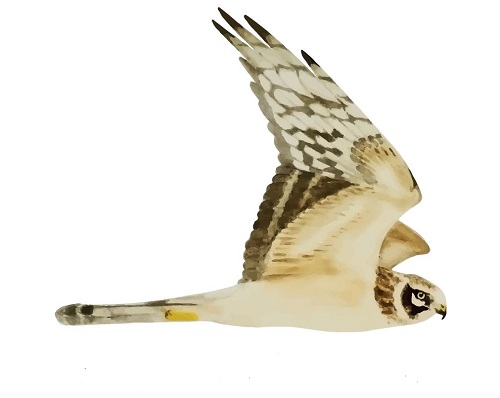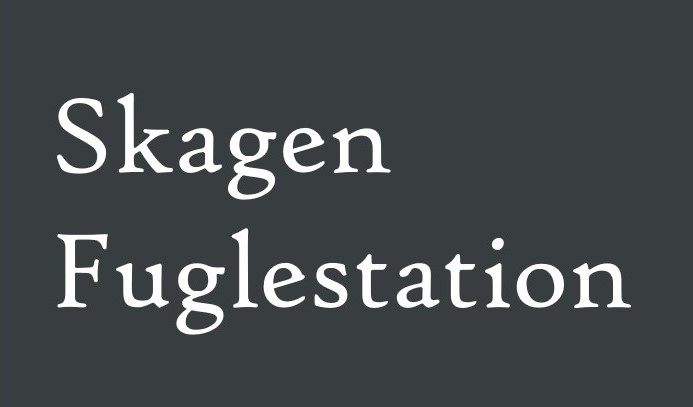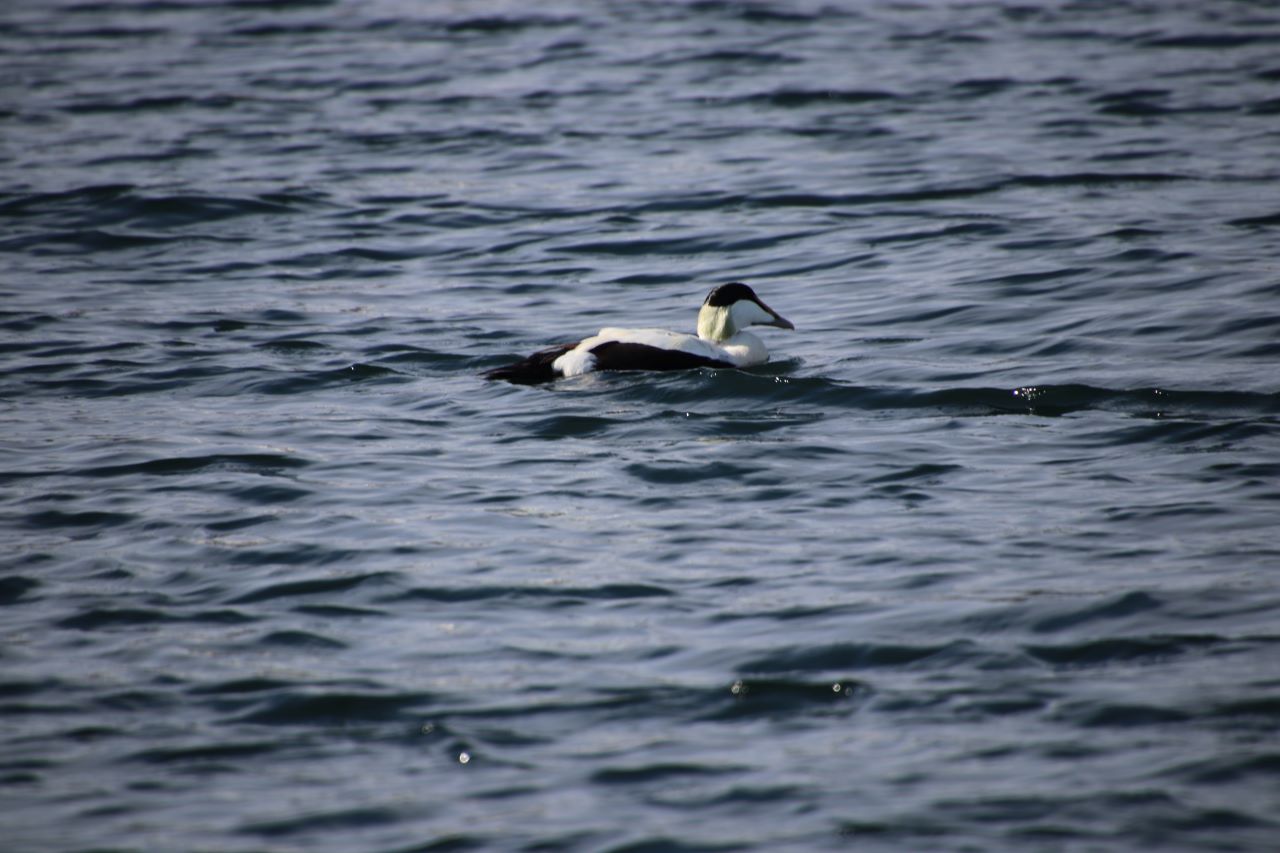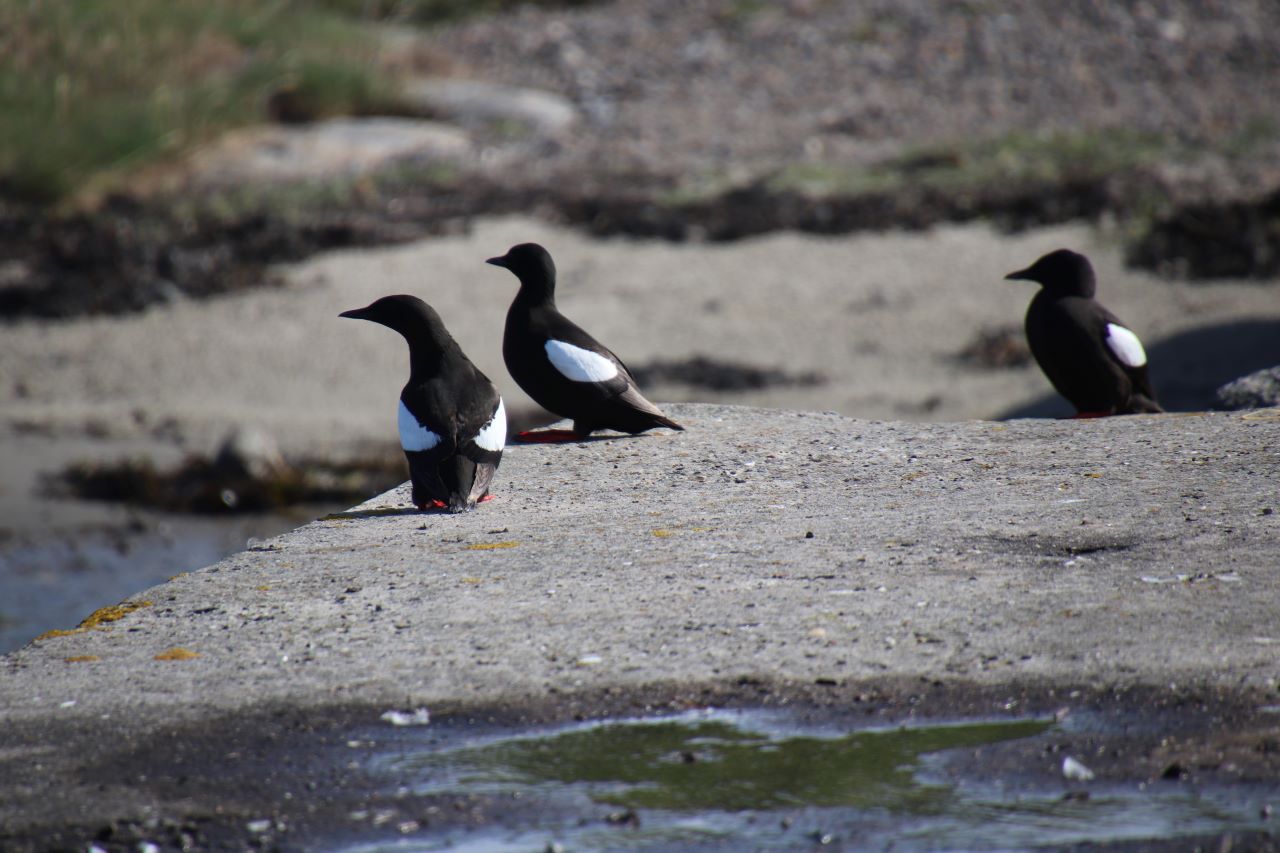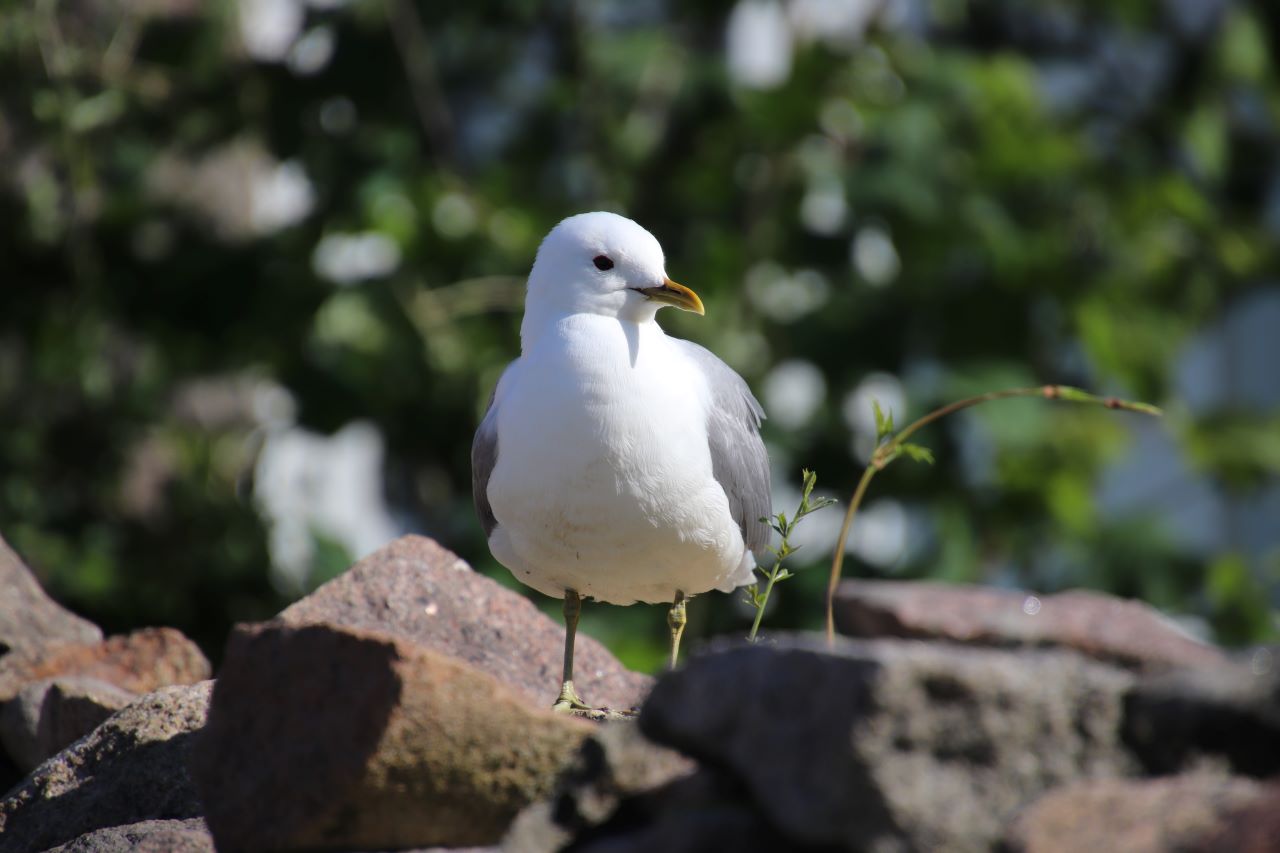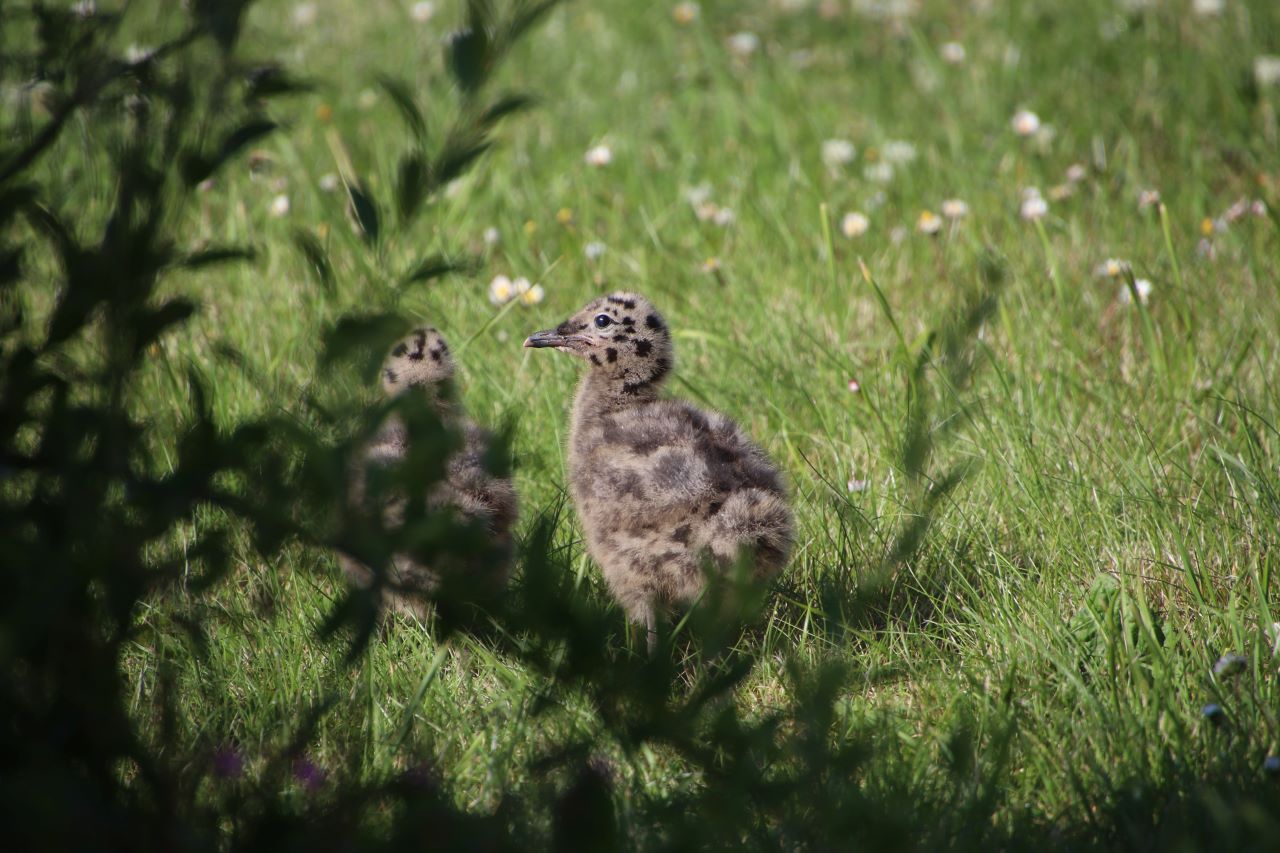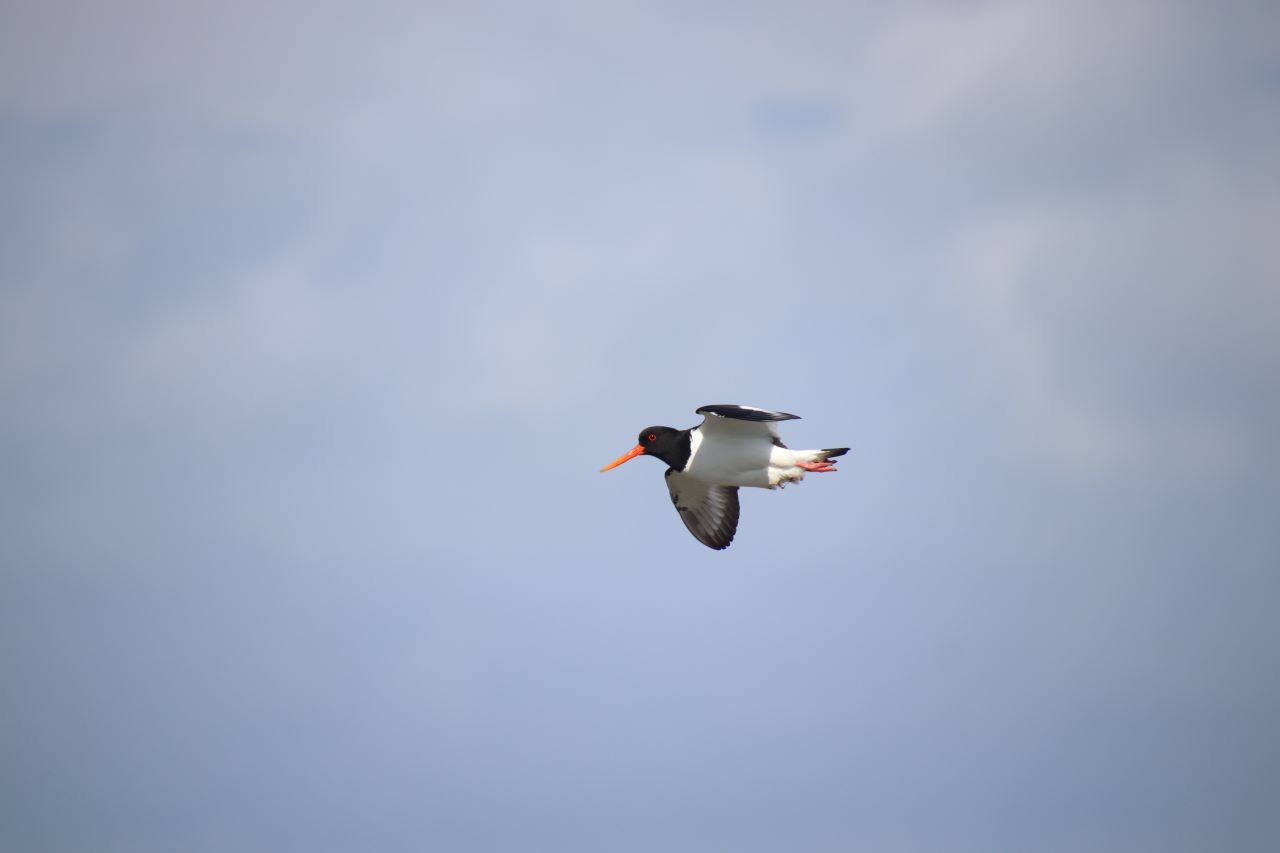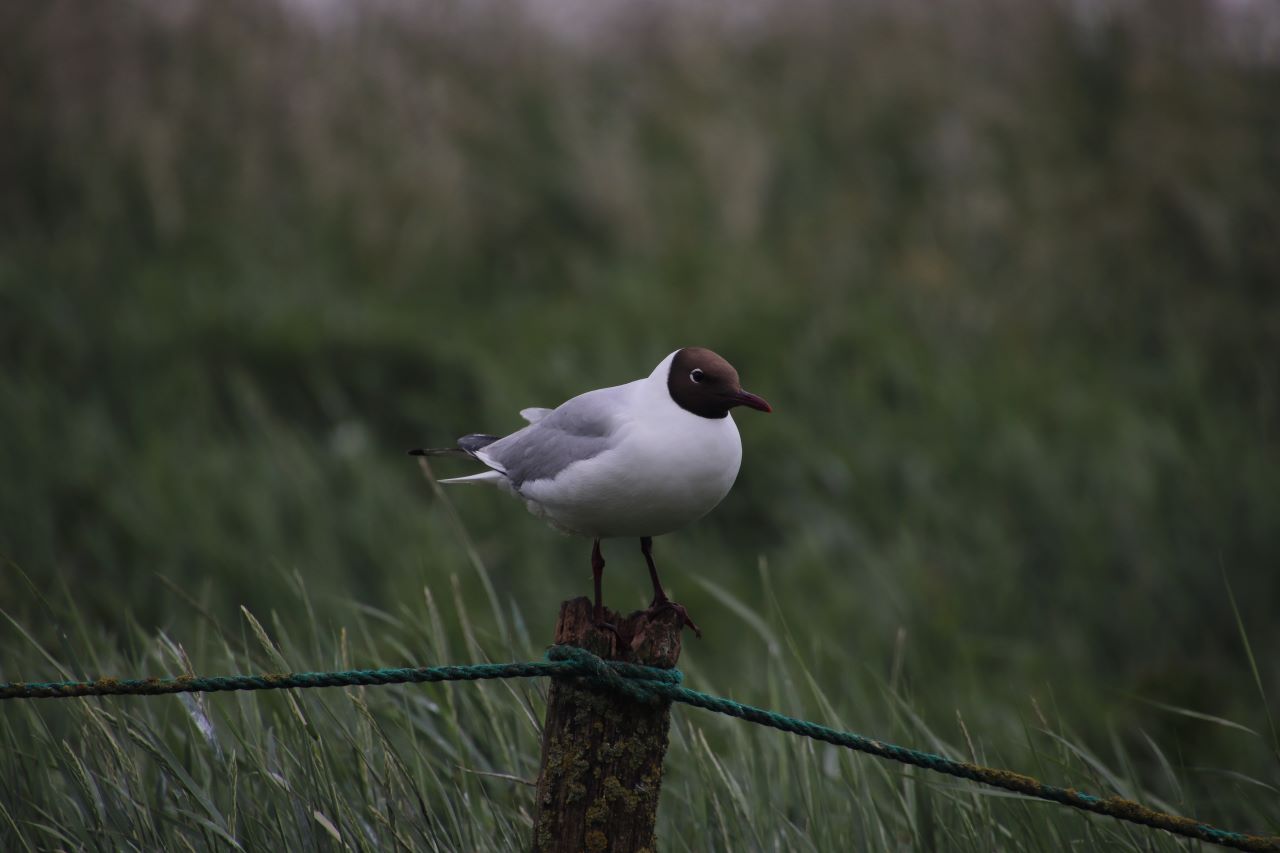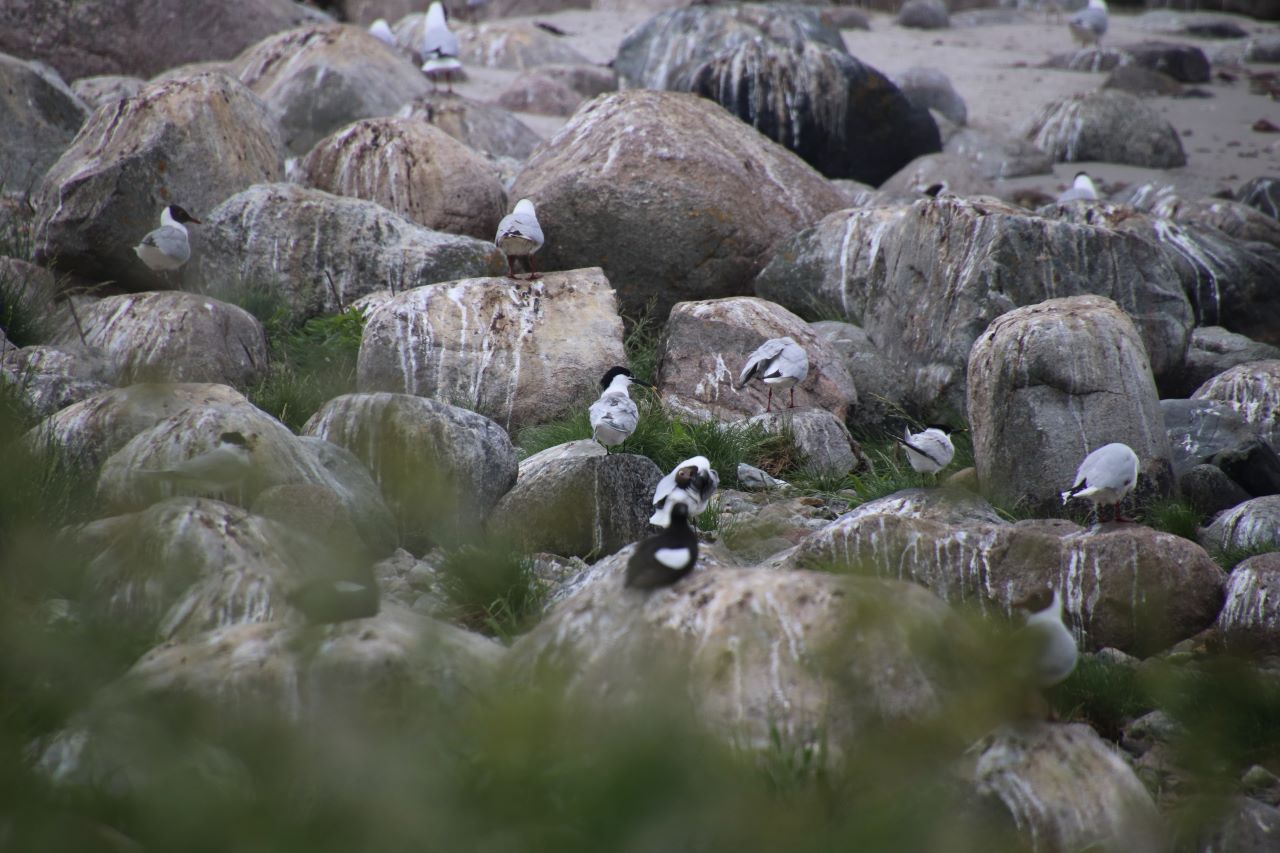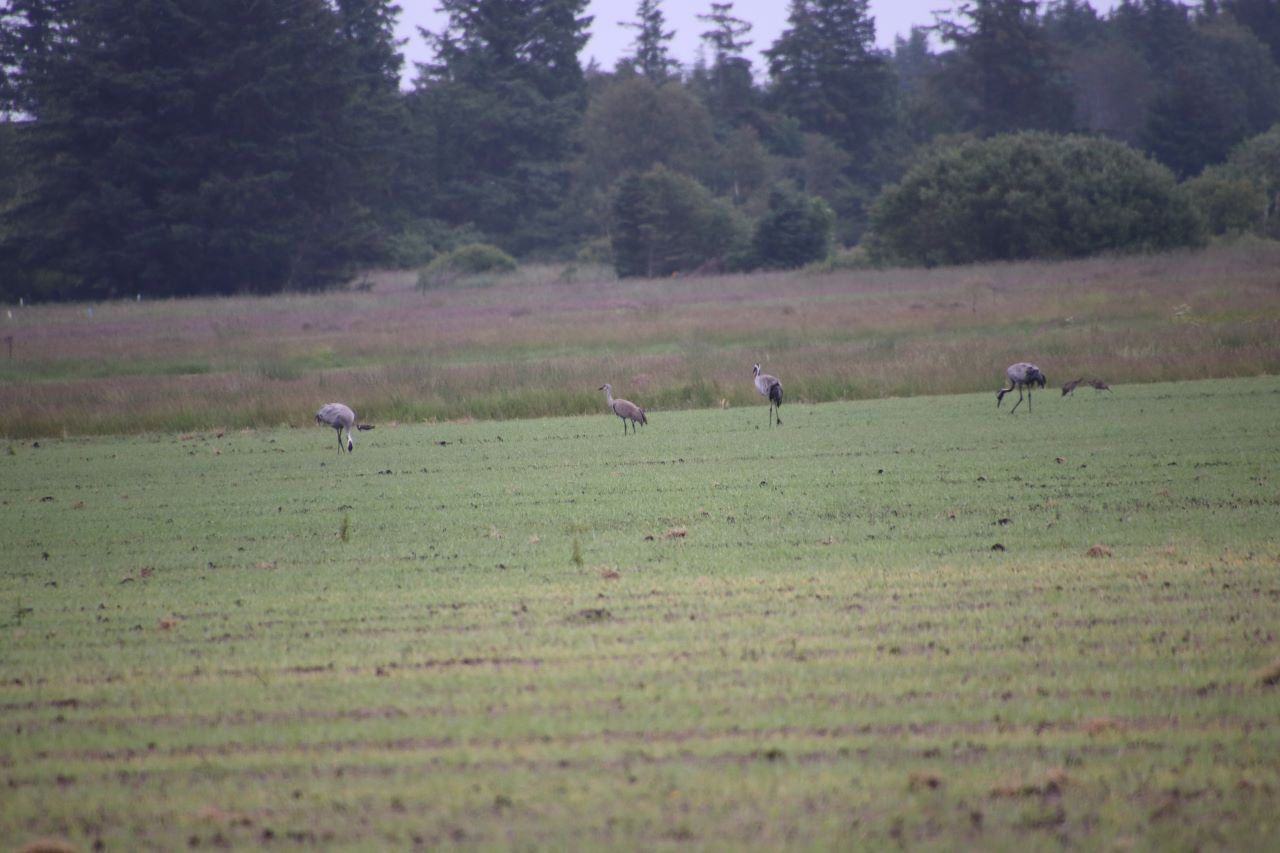Her på Skagen Fuglestations blog bringes korte nyheder i dagbogsformat om hændelser på fuglestationen.
Hayley Migrates West, Guillemot Frenzy!
This morning was a grey one, rainy, cold, and all our hearts felt the dark rift of Hayley’s departure. We shared one last group hug before Karen-Marie and Søren took Hayley to the train station. From bog witches, to toothbrush parties, to building weevil kingdoms, we have made many beautiful memories during Hayley’s stay here, and we all wish her the best of luck in Wales (and some good rest at home for the next 3 weeks). So to Hayley: hej hej and vi ses from SKAF, may our paths cross again some day!
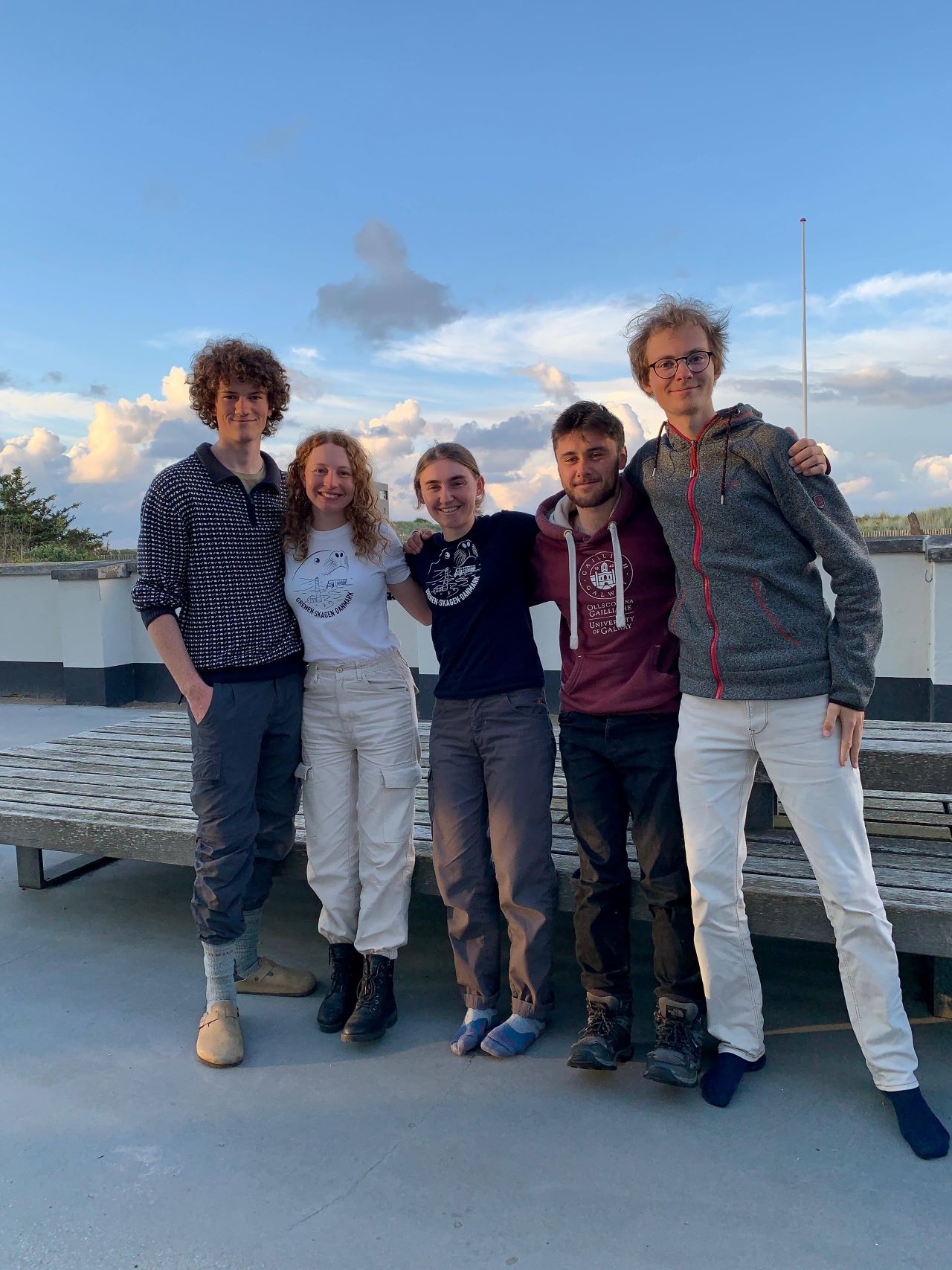
Team SKAF Spring 2024! Magnus Houen Lauritsen, Isis Khalil, Hayley Land, Seán Walsh, Simon Kiesé.
Fortunately, our routine was abruptly interrupted by today’s plans to visit Hirsholm, we had a nice amount of rest, some breakfast, and then we were off, with Seán joining Karen-Marie and Søren, and Simon and I joining Lars and his wife. Once we got to Frederikshavn, we were immediately greeted by Common Eiders (Ederfugl) and breeding Common Terns (Fjordterne), that was a good start!
Common Eider (Ederfugl).
Then we got introduced to our beautiful and valiant steed: SeaDog! SeaDog carried us through the Kattegat with ease, weaving through the waves and giving us all an exciting (and sick-free!) trip. Upon nearing the island of Hirsholm we had the most incredible sight, the early morning sun shone down on the few yellow homes that populate the island, and the lighthouse, while thousands of seabirds took to the skies to make their presence known. The number of Black Guillemots (Tejst) was absolutely crazy, they were sitting on every stone, their bright red feet peaking out from beneath their stunning black-and-white plumage. Many words filled my head, but now that I sit to write about the experience, none seem quite adequate enough to communicate the feeling that view gave us. Cinematic in every way.
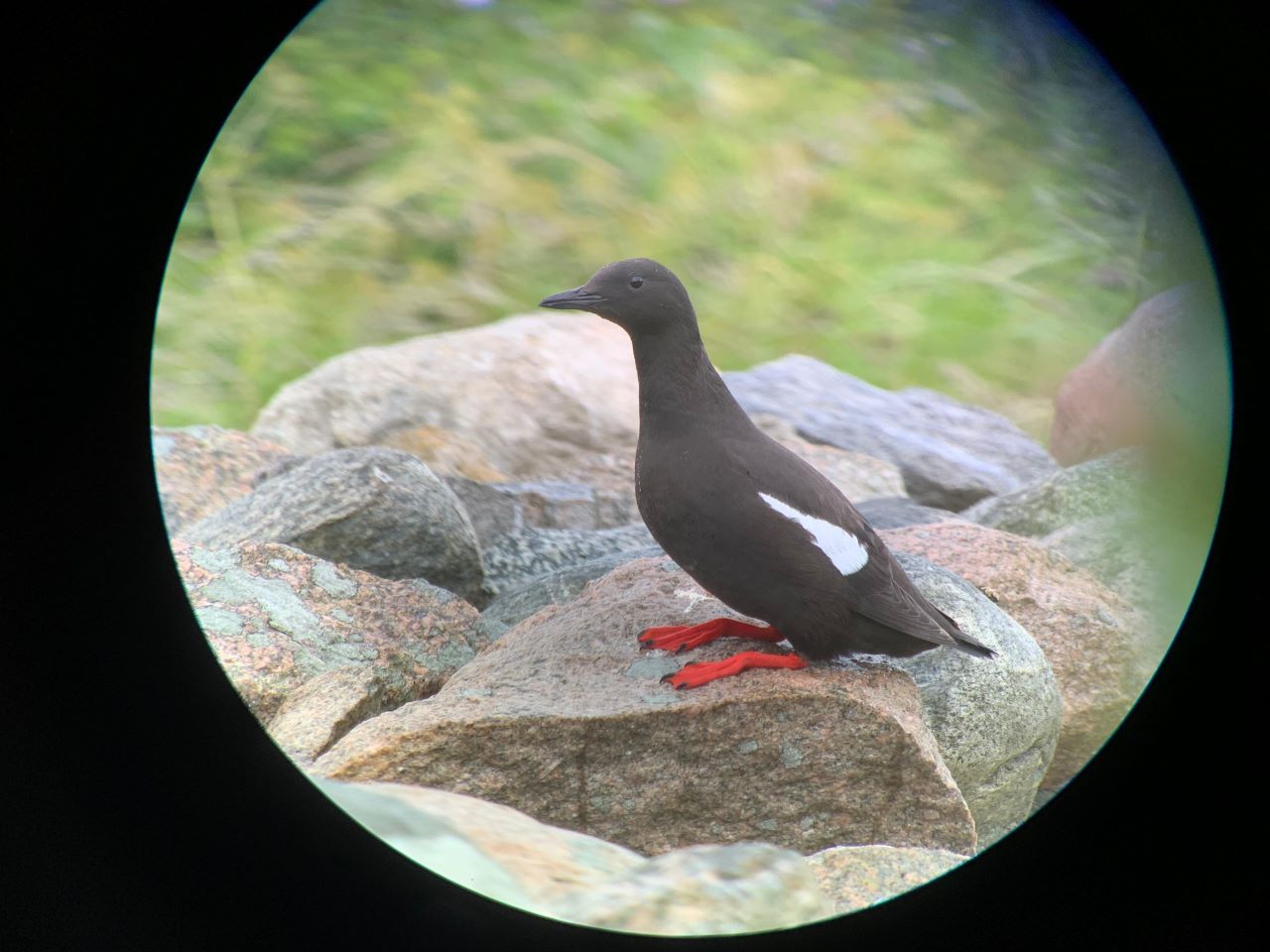
Black Guillemot (Tejst). Photo by: Simon Kiesé.
Once off the boat, we barely made it a few steps onto the harbour before we had to stop to spend time watching and photographing the Black Guillemots (Tejst). I could have stayed in just that spot forever, there was simply so much to see! But we made an effort to explore the rest of the island nonetheless, with such a beautiful start, we knew there was much more excitement in store for us. As we walked through the preset paths, between the old homes, and around the gardens, we were greeted by many Common Gulls (Stormmåge) and their chicks (Pulli) running around, several Black-Headed Gulls (Hættemåge) and their chicks (Pulli) also running around, and quite a few clumsy Red-Breasted Mergansers (Toppet Skallesluger) crash landing into the grass or sea.
Black Guillemot (Tejst).
Common Gull (Stormmåge).
Gull (Måge) chicks (pulli).
Eventually, we found ourselves perched atop an old bunker, scopes pointed North towards Græsholm, scanning for any special birds. As expected, and thanks to a tip from Morten, Simon spotted a European Shag (Topskarv) sitting on top of a rock in a flock of Great Cormorants (Skarv), that was cool! Seán also saw a Rock Pipit (Skærpiber) fly by, but no one else got to see that one (not to worry, though, we all saw a few later on in the day). As we were eating some snacks and scanning the North, we noticed a White-Tailed Eagle (Havørn) flying in, causing hundreds of Great Black-Backed Gulls (Svartbag) and Herring Gulls (Sølvmåge) to jump up from their roost, screaming in a wild frenzy. It was an incredible sight.
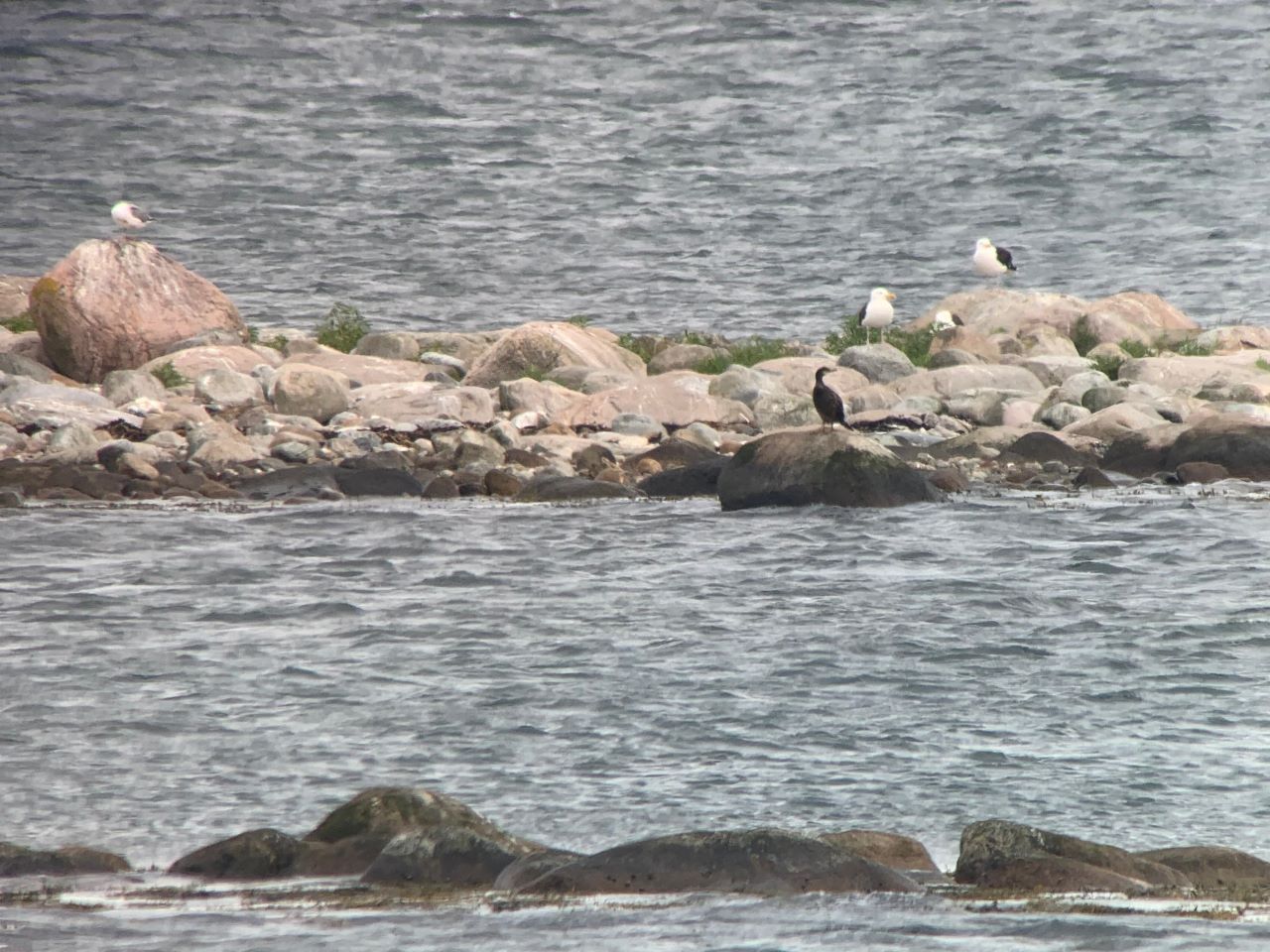
European Shag (Topskarv). Photo by: Simon Kiesé.
Eurasian Oystercatcher (Strandskade).
We made our way back South along the coast of the island, seeing many fun plant, insect, and bird species. Eventually we passed through some woods where we heard a few Great Tits (Musvit) calling. Then we were back at the harbour, this time we continued in the opposite direction, coming across the Black-Headed Gull (Hættemåge) breeding colony, and getting to see lots of Sandwich Terns (Splitterne) perching and fishing. Unfortunately, it also started to really rain during this, so we had to finish exploring the island soggy and cold. Damp, shivering, and hungry, but satisfied in most every way.
Black-Headed Gull (Hættemåge).
Cool jellyfish!
Sandwich Tern (Splitterne).
Thankfully, there wasn’t too much time left before SeaDog came to rescue us, sporting a surprisingly comfortable interior (with a Seal head mounted, watching over us). We were sloshed around rather violently by the sea, but it was the source of many laughs. A free rollercoaster ride, so to say. At one point the SeaDog crew told us it was safe to go outside on the boat again, so naturally we took the opportunity to bounce around in the waves, feeling the spray of the sea on our faces, and pretending we were vikings on a quest to spread the glory of herring on rye bread. Arghh! Onwards!
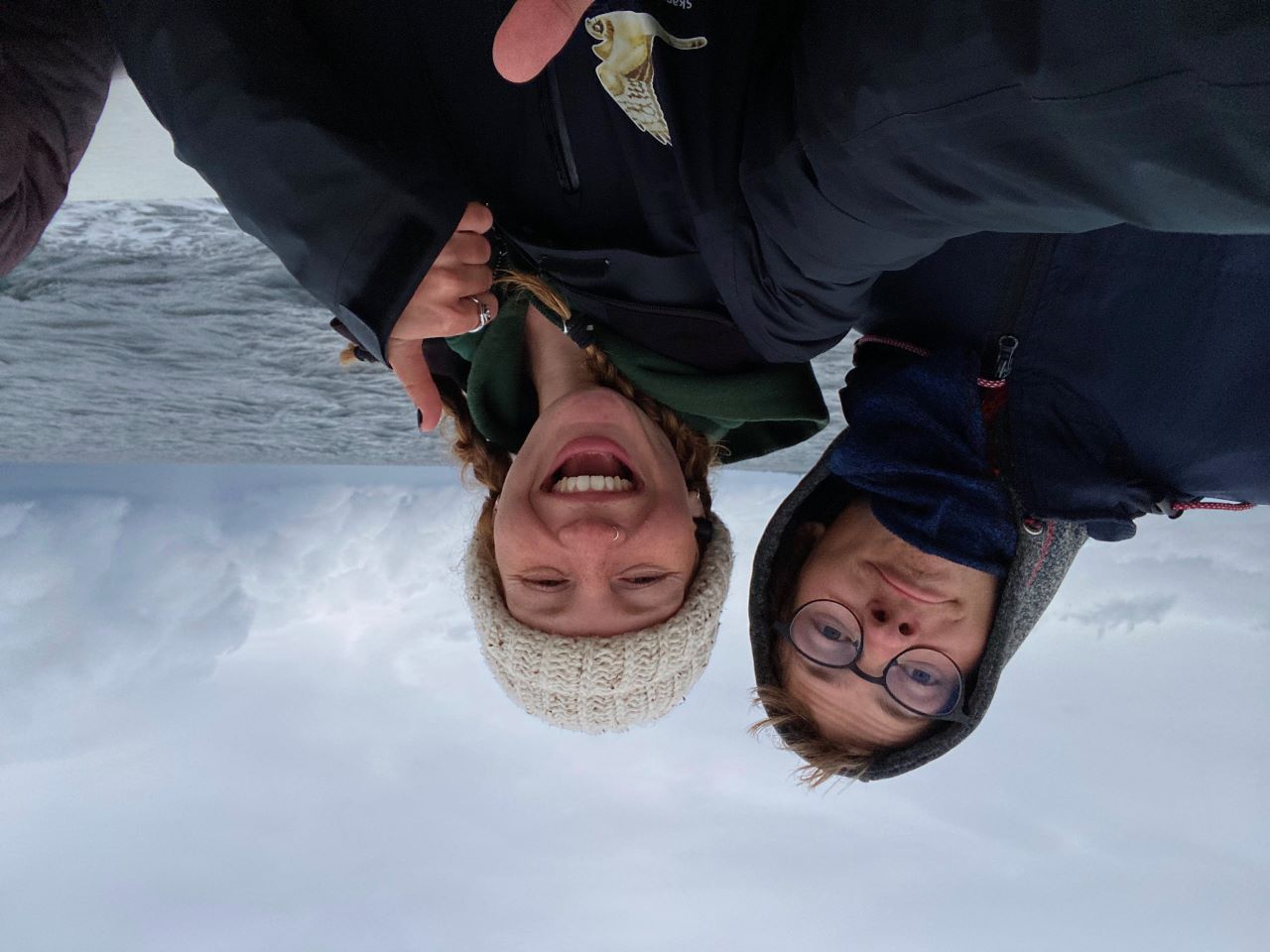
Simon and I braving the storm.
Though it was plenty of fun being out in the waves, it resulted in us being drenched by the time we reached Frederikshavn. The warmth of our cars was a comfort unlike any other, and soon we were on the road again, but not towards the station yet… news of a Sandhill Crane (Prærietrane) reached us through Zello, and conveniently, it was right on the way back for us! Ironically enough, the Sandhill Crane (Prærietrane) was in one of the fields where we had been putting up beetle traps yesterday, near Råbjerg Kirke. Lucky us! We all got an incredible view, snapping pictures of it side-by-side with Common Cranes (Trane), the difference is very evident!
Sandhill Crane (Prærietrane) surrounded by Common Cranes (Trane).
Finally, our adventure came to reach its conclusion. The feeling of being home, warm, clean, and with a full stomach, was heavenly. Immediately we all got to work processing the data and pictures of the day, for here the work is never truly over.
While we were in Hirsholm, Simon (Sr) was hard at work at Kabeltromlen. Though ringing was interrupted by rain, Simon (Sr) and Henrik still managed to ring a few birds. They even caught a Common Whitethroat (Tornsanger) that was ringed in 2019. Then Simon (Sr) joined us at the station for our evening meeting, some planning, and to set up/fix some nets in the old lighthouse garden with Seán and I.
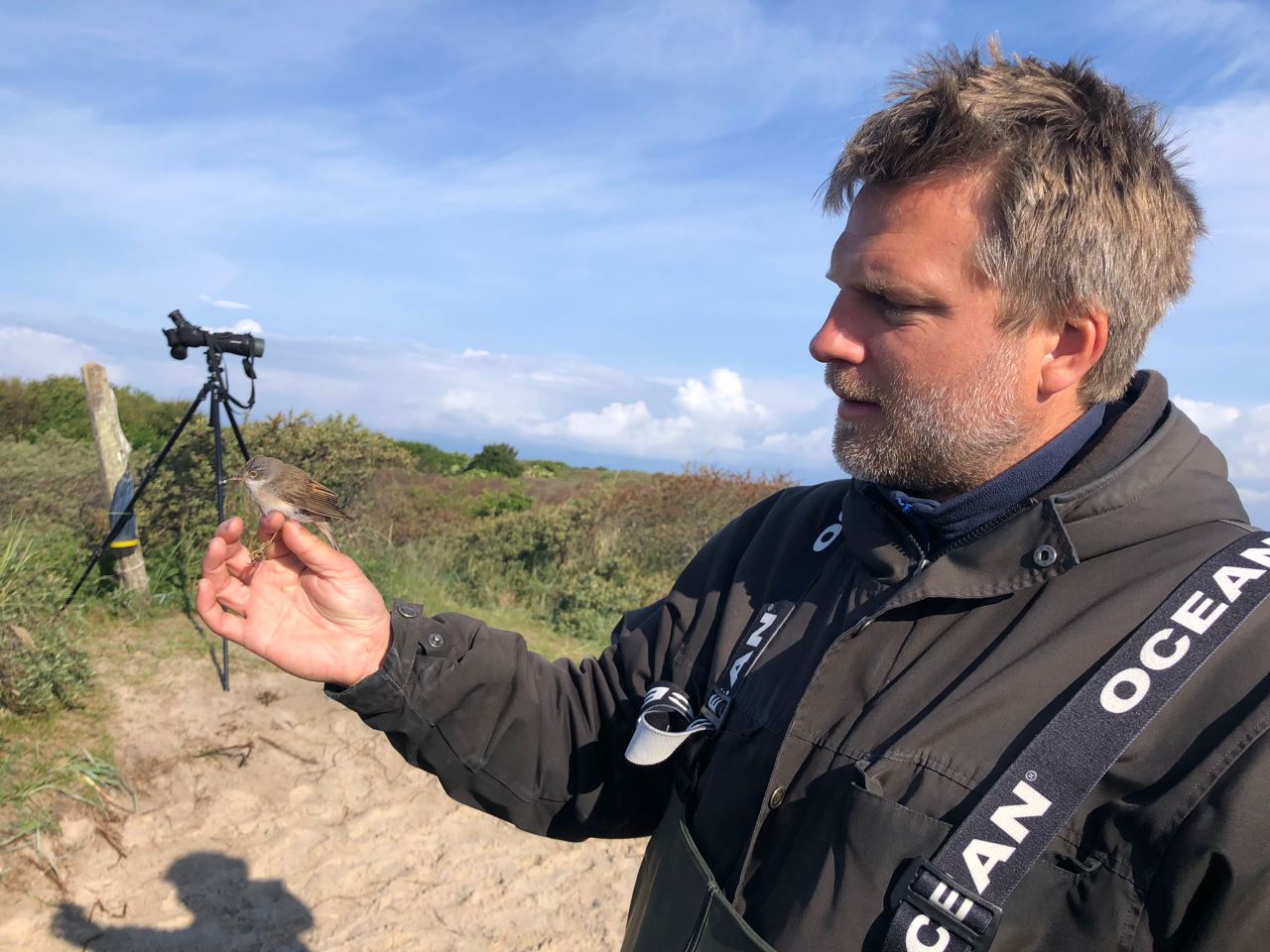
Simon S. Christiansen shows off a recapture Common Whitethroat (Tornsanger) from 2019.
In the meanwhile, Magnus braved the harsh weather to do the migration count. Then he migrated further south to spend time with his “naturalist friend”.
At long last, the beautiful day came to its end. Simon (Jr) prepared a wonderful curry for us, Karen-Marie and Søren took care of drinks and chips (and naan), and we all shared one last meal together before Karen-Marie departs back to Copenhagen tomorrow.
Soon after dinner our beds were calling our names, and our eyelids fell heavy over our eyes. Tomorrow looks quite uncomfortable, there may not be an opportunity to go ringing, but there will be plenty of work to do regardless.
Thank you everyone for such a great day and incredible experience at Hirsholm!
Ringing (Kabeltromlekrattet)
| Reed Warbler |
Rørsanger | 2 | RI | |||||||||||||
| Blackcap | Munk | 7 | RI | |||||||||||||
| Icterine Warbler | Gulbug | 1 | RI | |||||||||||||
| Common Whiterhroat | Tornsanger | 1 | RI | |||||||||||||
| Marsh Warbler | Kærsanger | 1 | RI |
Total: 12
Today’s observations in Dofbasen from observers in the area.
Sum of the raptors in the area based on observations typed into Dofbasen the same day.
People: Seán Walsh, Hayley Land, Isis Khalil, Magnus Houen Lauritsen, Simon Kiesé, Simon S. Christiansen, Karen-Marie and Søren Leth-Nissen, Lars Yttte & Sussi, Morten Christensen, Henrik Knudsen, Laila Neerman.
The best last day in Skagen
Daily the marmot greets (z.dt.: täglich grüßt das Murmeltier) and we were out before sunrise at Grenen. It was really cold today, mostly caused by some wind, rain in the night and the leck of sun. There were still Fulmars (Mallemuk) flying out of Kattegat, but with 70 birds during the morning the numbers lowered from the previous days. Nearly 7000 Scoters (Sortand) got klicked by Magnus and me on their daily movement from the Kattegat to the Skagerrak. When I was watching a Sanderling (Sandløber) roosting at the beach, two small balls of fluff caught my eyes. Those two cute creatures were running over the beach looking for food and then quickly back to their parents to get warmed under their plumage. I called Hayley at Kabeltromlen, if someone can come and bring the ringing equipment for those and a few minutes later Karen-Marie came and we approached the young Common Ringed Plover (Stor Præstekrave) family.
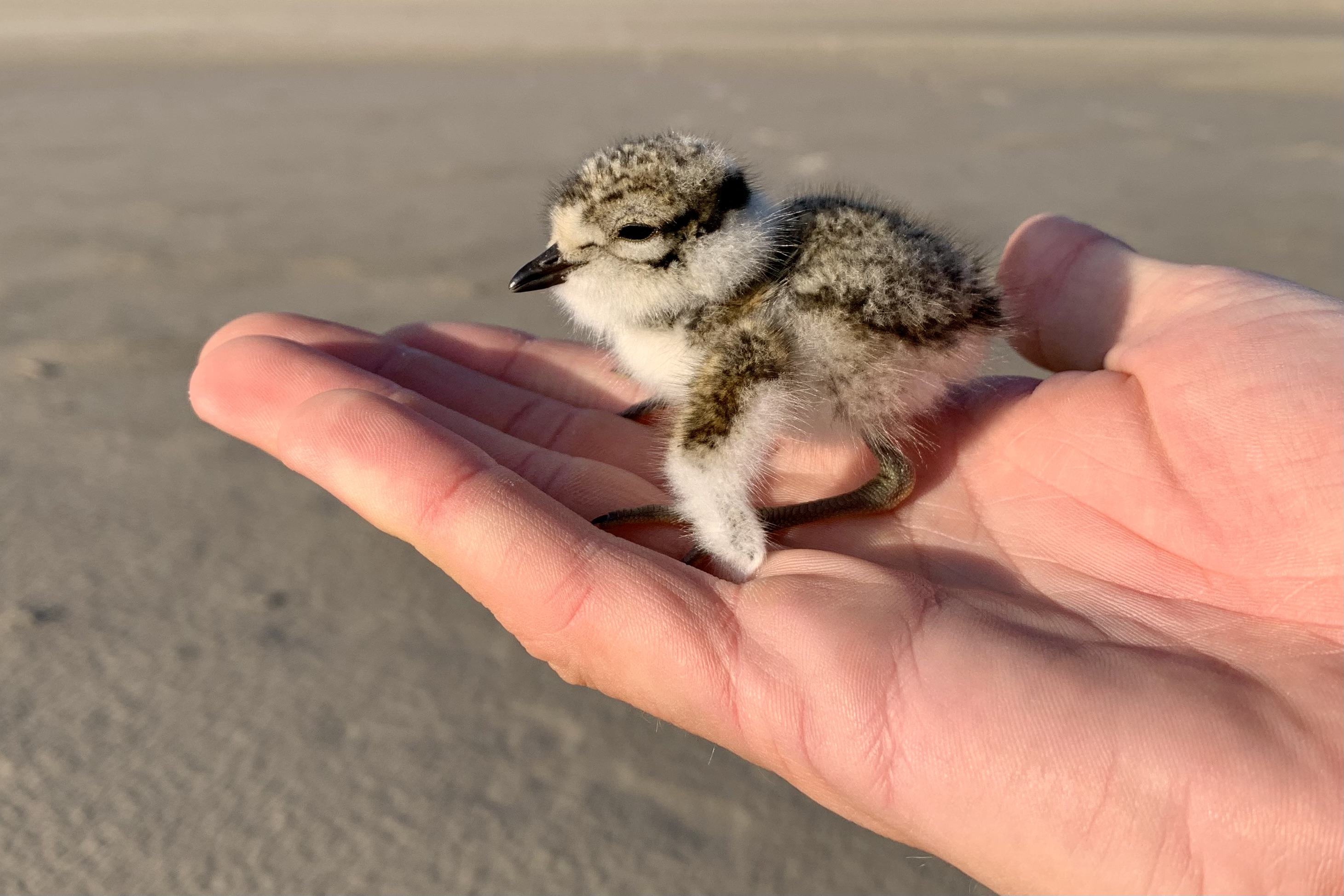
Now there were four chicks (pulli), we could quickly ring and then release them together to their waiting parents. As soon as we left, the parents came back and continued their job as heat pads. That was nice!
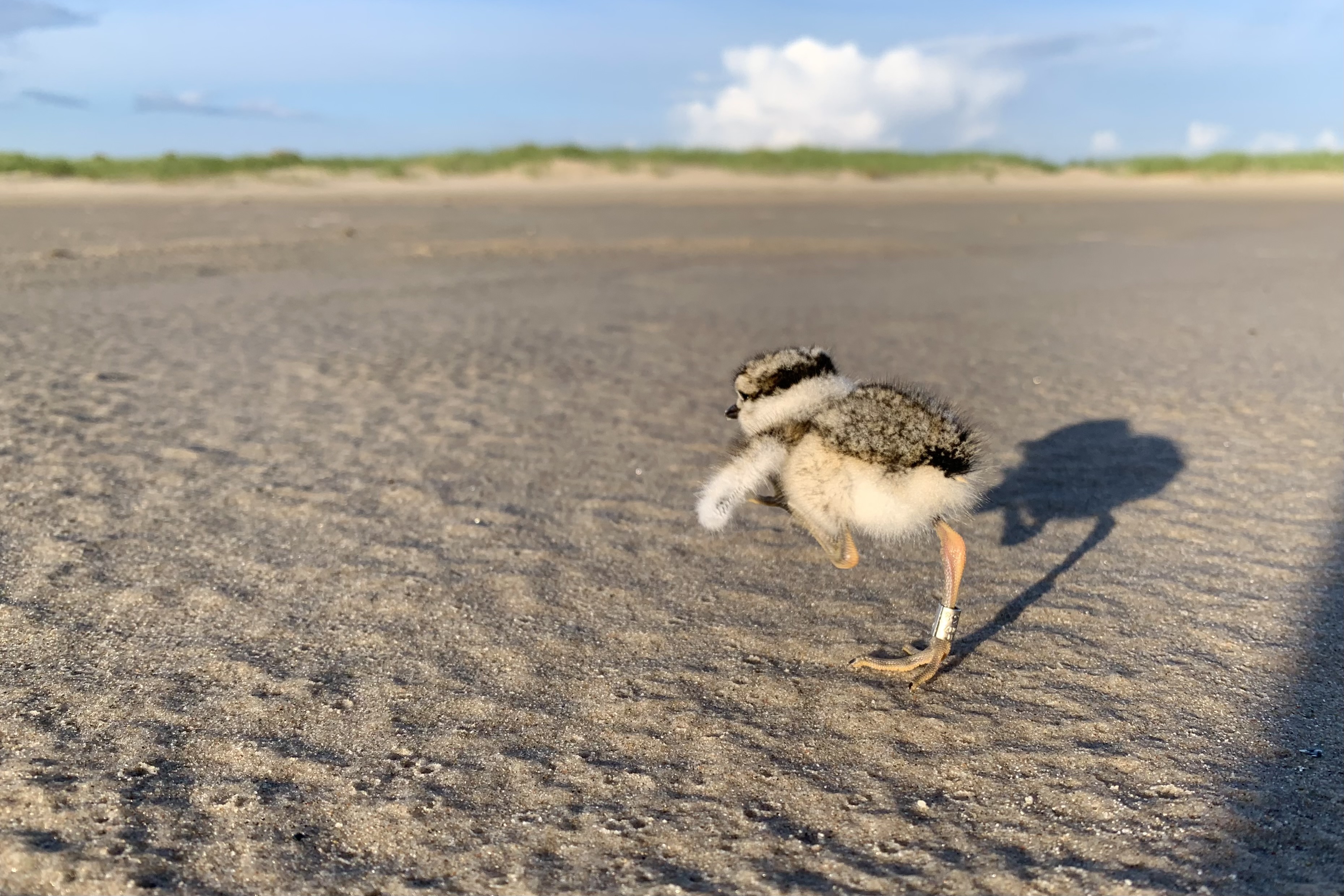
In the meanwhile (every time I write this I have the song by Spacehog in my mind), the tough ringers including Hayley, Isis and Seán were enjoying many Blackcaps (Munk) at Kabeltromlen. The number of birds was okay, but the highlight for Hayleys last day here (enter sad emoji) was still missing. This had to be changed! The second Red-backed Shrike (Rødrygget Tornskade) in the ringing this year should change this, because it was not just a rarely caught bird but also the first male for us. Look at this super cool bird!
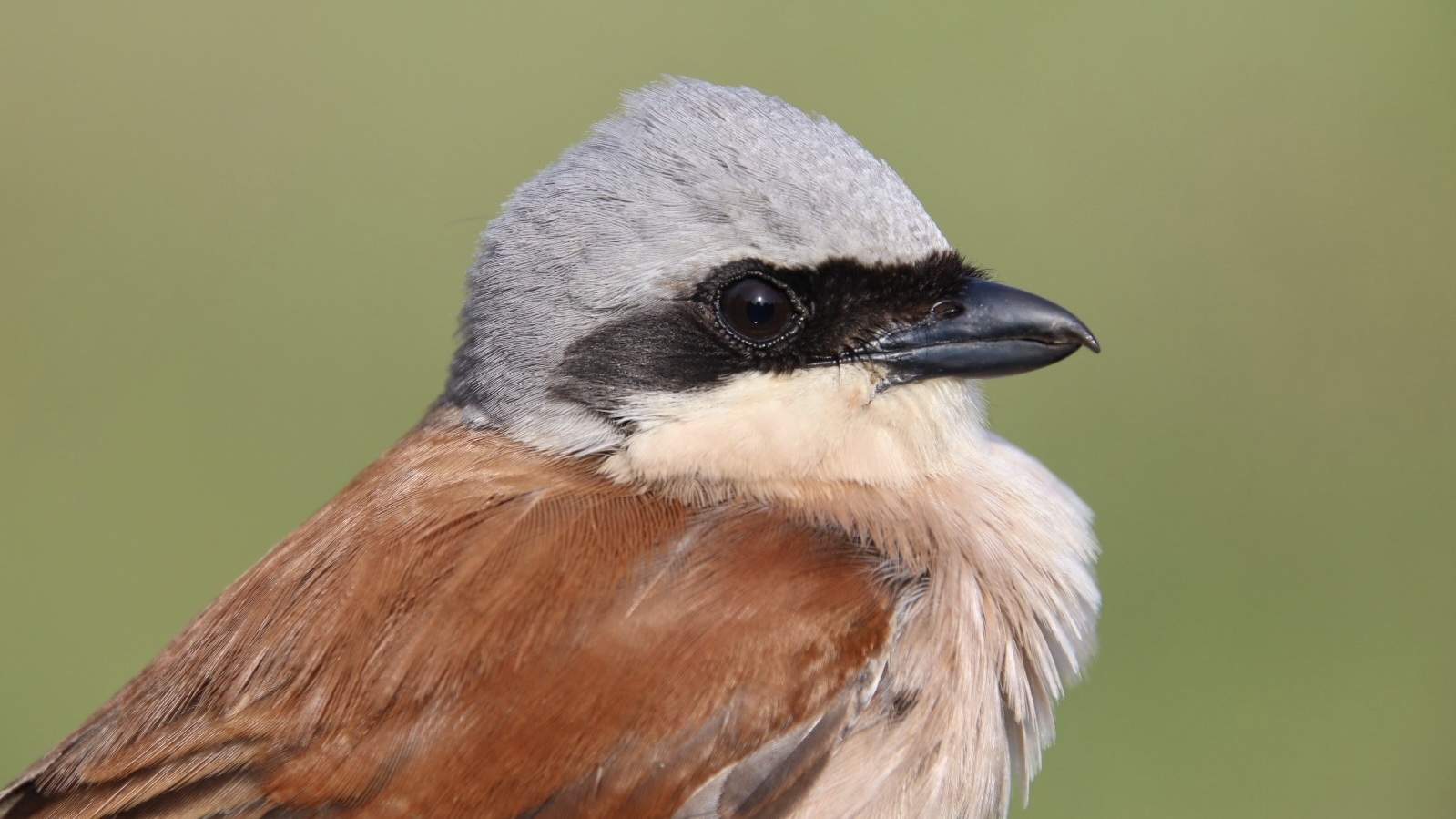 Red-backed Shrike (Rødrygget Tornskade) - picture by Isis Khalil
Red-backed Shrike (Rødrygget Tornskade) - picture by Isis Khalil
The closing round brought another ”big” surprise – a Jay (Skovskade)! This was a fitting surprise before Hayley migrates back to the UK tomorrow (a weird direction for June, is’nt it?).
In the noon, a Sandhill Crane (Prærietrane) was found, but lost quickly due to the upcoming rain. This is a crazy record, because it is already the second one this year in Skagen and just the third ever here. The species is really rare in entire Europe and most of the birds turn up to be refound over several years at different places. Now it looks like there are two birds around. The last one migrated to Sweden and recently there was one in the Netherlands, so maybe it came up now? In anyway a great find, congrats to the finders.
One of the four Blyth's Reed Warblers (Buskrørsangere) found yesterday was still present today at Guldmajssøen. Knud got some some very nice close up pictures while it was performing it's remarkable song.
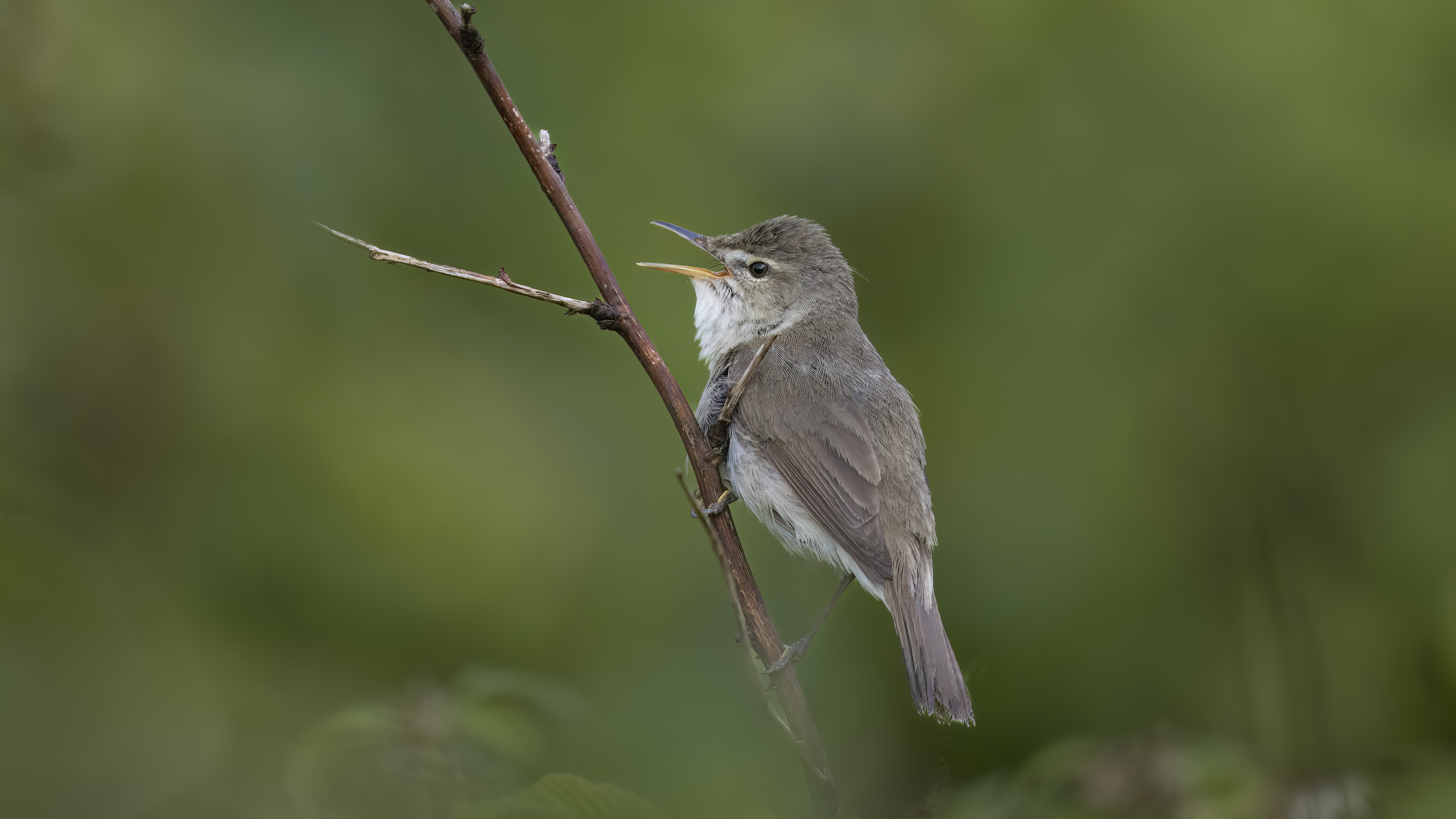 Buskrørsanger (Blyth's Reed Warbler), Guldmajssøen. Foto: Knud Pedersen
Buskrørsanger (Blyth's Reed Warbler), Guldmajssøen. Foto: Knud Pedersen
What could be worse than losing a volunteer and good friend at the Bird Observatory? Nothing. That’s why we try very hard to enjoy all the last minutes together with Hayley. We took this as a reason to spend a nice afternoon together with our guests and Simon Sr., who invited us to Skagen Bryghus for lunch. We sat outside but than the rain started. Luckily big umbrellas protected us from getting wet, but it got a bit cold so we got some blankets. The food was really good.
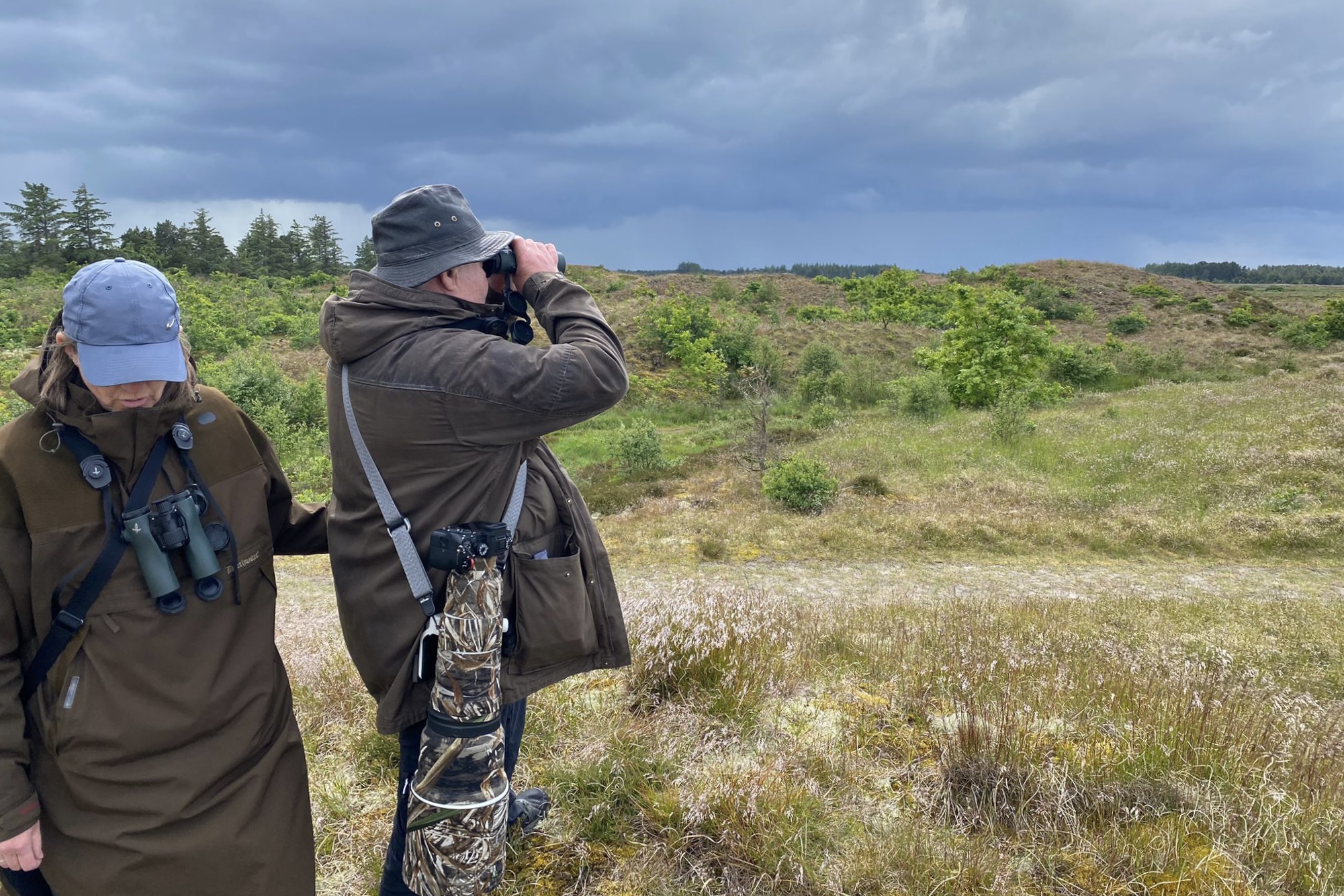
Afterwards we continued to Råbjerg Kirke to put out some beedle traps for a pupperøvere together with Magnus. This was a great opportunity to look at some plants and insects of the area. Unfortunately, the weather was too bad to get many insects, but some orchidees got our attention. I did not expect to say that, but it was really fun!
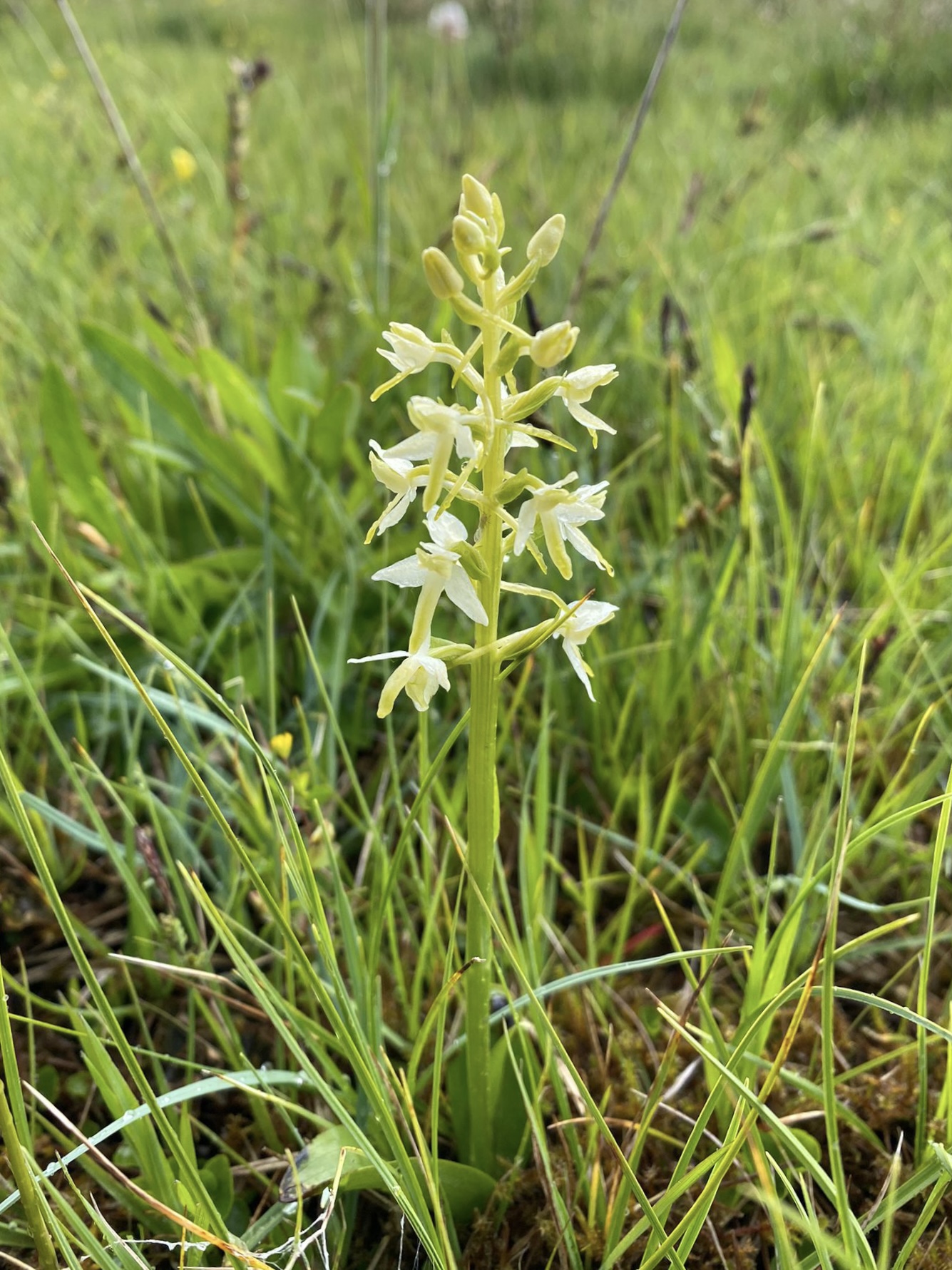 Magnus infected us with his passion for plants aswell.
Magnus infected us with his passion for plants aswell.
At one place there were three Corn Buntings singing. We got some nice views of them, which is great, since it was a new species for Hayley. Get some nice views on a roosting Hayley:
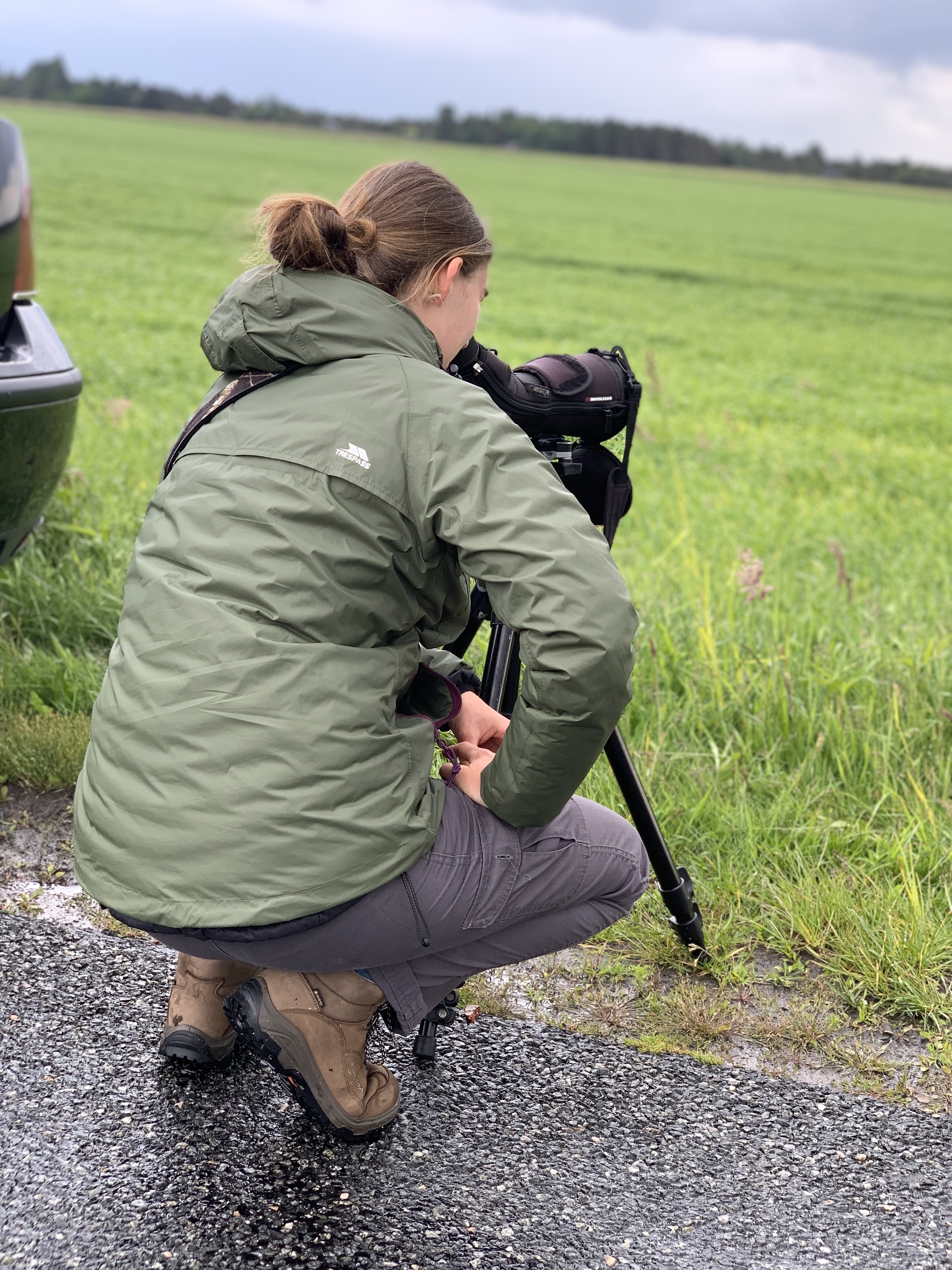
To end the fun day, we went to Aalbæk into the Belgium Beer House (Det Bette Ølhus) in Ålbæk. Since a quarter of Isis’s blood is from Belgium, I trusted her advice for a good beer. What should I say – I did not get dissapointed. I think all of us enjoyed the place and it was nice to spending some time together, drinking, eating and chatting.
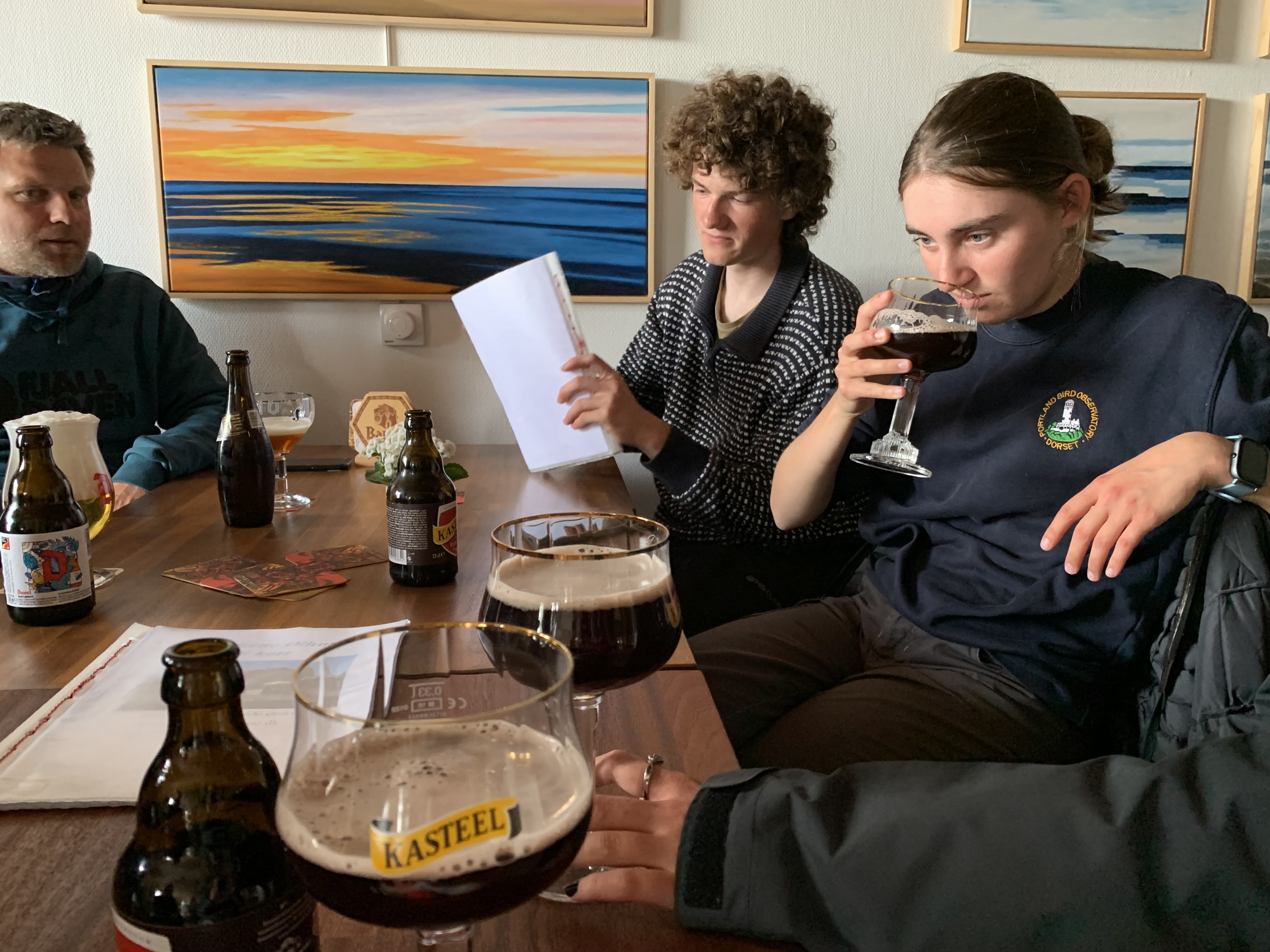
Ringing (Kabeltromlekrattet):
Total: 42
Ringing (Grenen):
Common Ringed Plover (Stor Præstekrave) - 4
Total: 4
A link to today's observations from volunteers and local observers.
Sum of observations of raptors on DOFbasen from today.
People: Hayley Land, Isis Khalil, Magnus Houen Lauritsen, Seán Walsh, Simon Kiesé, Simon S. Christiansen, Henrik Knudsen, Karen-Marie and Søren Leth-Nissen, Knud Pedersen.
Double take
As yet another CES session loomed on us volunteers, it was once again Skarvsøen vs. Kabeltromlen. Teams: IK, SK, HL, KLN (Karen-Marie Leth Nissen) vs. SSC, SW and HKN (Henrik Knudsen). The catch numbers in the last split day were equally as poor in both sites, but Skarvsøen took the trophy home with a Buskrørsanger (Blyth's Reed Warbler), 3rd for Skagen Fuglestation.
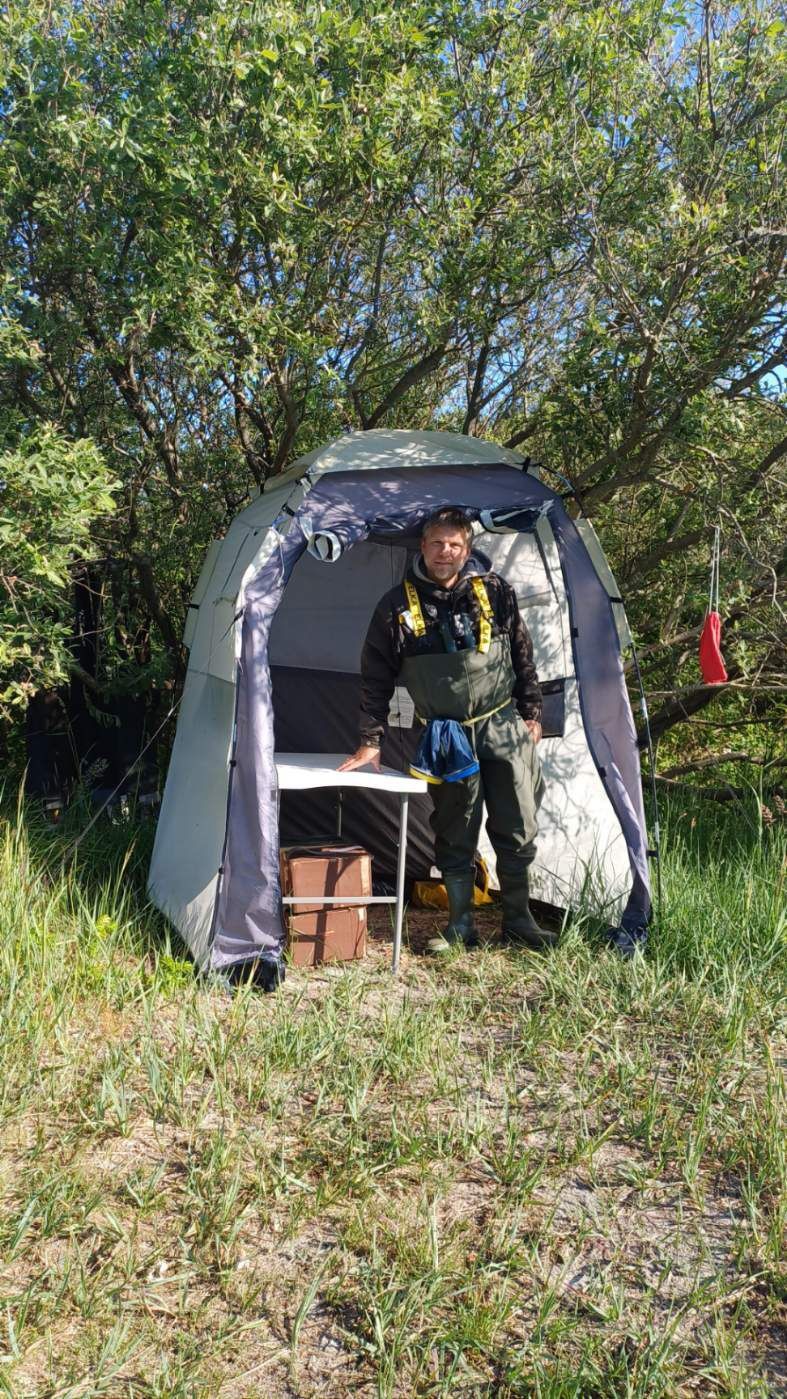 Rare image of SSC in waders (foto: Hans Rytter)
Rare image of SSC in waders (foto: Hans Rytter)
As the sole net-opener for Kabeltromlen, I was the first out of the observatory this morning. I began opening nets at 02:50, and had all nets open an hour later. I was joined by Simon and Henrik for the first round to begin ringing. Kabeltromlen got off to a good start with 8 birds in the initial net check, followed by a whopping 19 in the second (plus two Bogfinker (Chaffinches) ill with avian papilloma virus which we do not ring). The next couple rounds were done in rapid succession because the weather wasn't the best. During one of these hectic rounds, I came back with a Buskrørsanger, 4th for the Observatory and the first time more than one had been caught by us in one year. This one was especially surprising for Simon because him and Henrik could still hear a totally different Buskrørsanger, that they found singing close by short time before. Unfortunately, we weren't succesful in catching the other individual. It would've been too good to be true. In the end, there were a total of 38 ringed and recaptured birds (excluding sick birds).
But more Buskrørsangere (Blyth's Reed Warblers) was observed in the area during this day bringing the total up to at least 4 individuals (including birds found at Butterstien and Guldmajssøen) - a new record day for this species in Skagen! You can listen to them on recordings oploadet to Dofbasen.
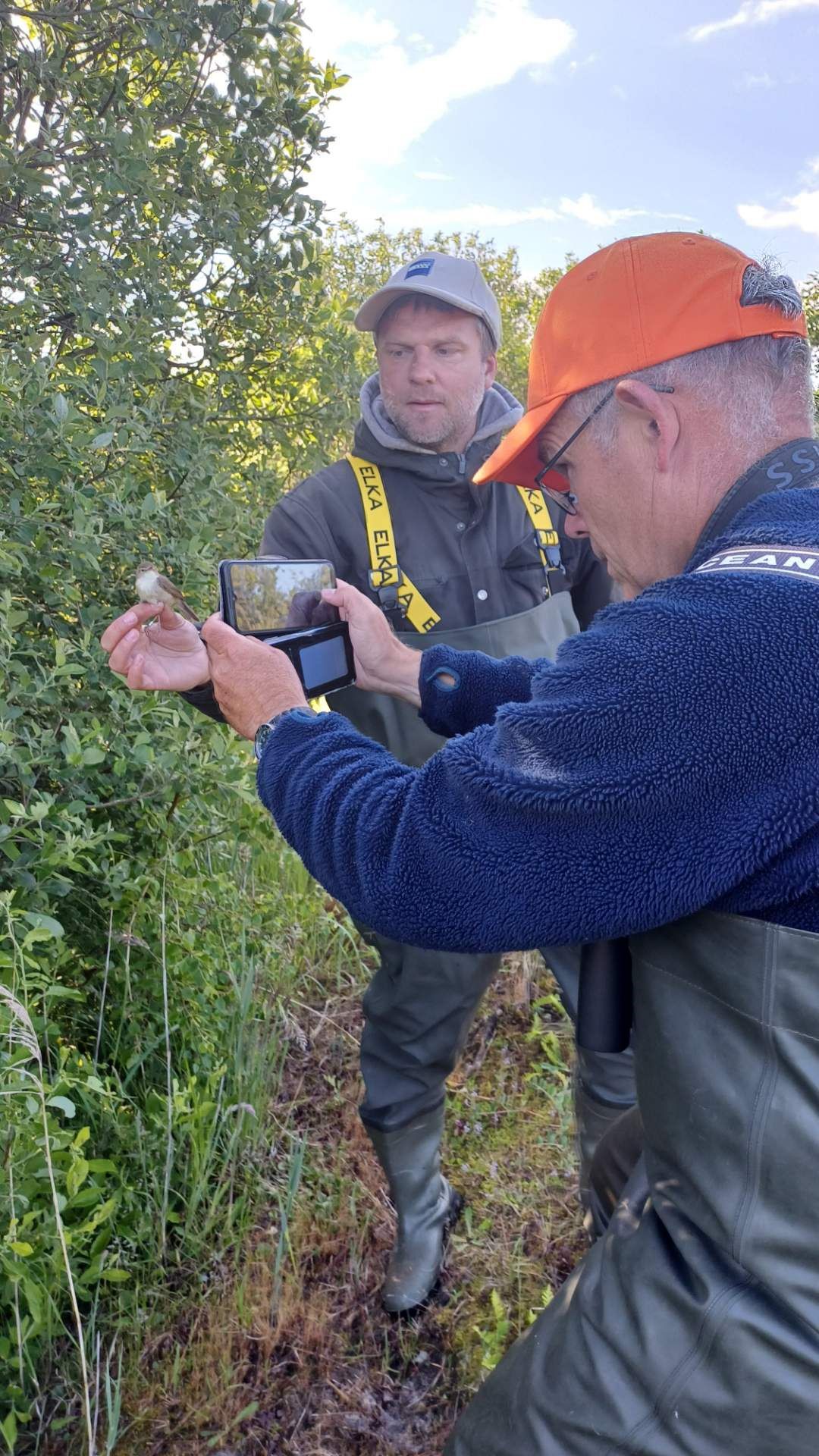 Henrik Knudsen, Simon (Senior) a Blyth's Reed Warbler (Buskrørsanger) and some cool caps from Zeiss. Foto: Hans Rytter
Henrik Knudsen, Simon (Senior) a Blyth's Reed Warbler (Buskrørsanger) and some cool caps from Zeiss. Foto: Hans Rytter
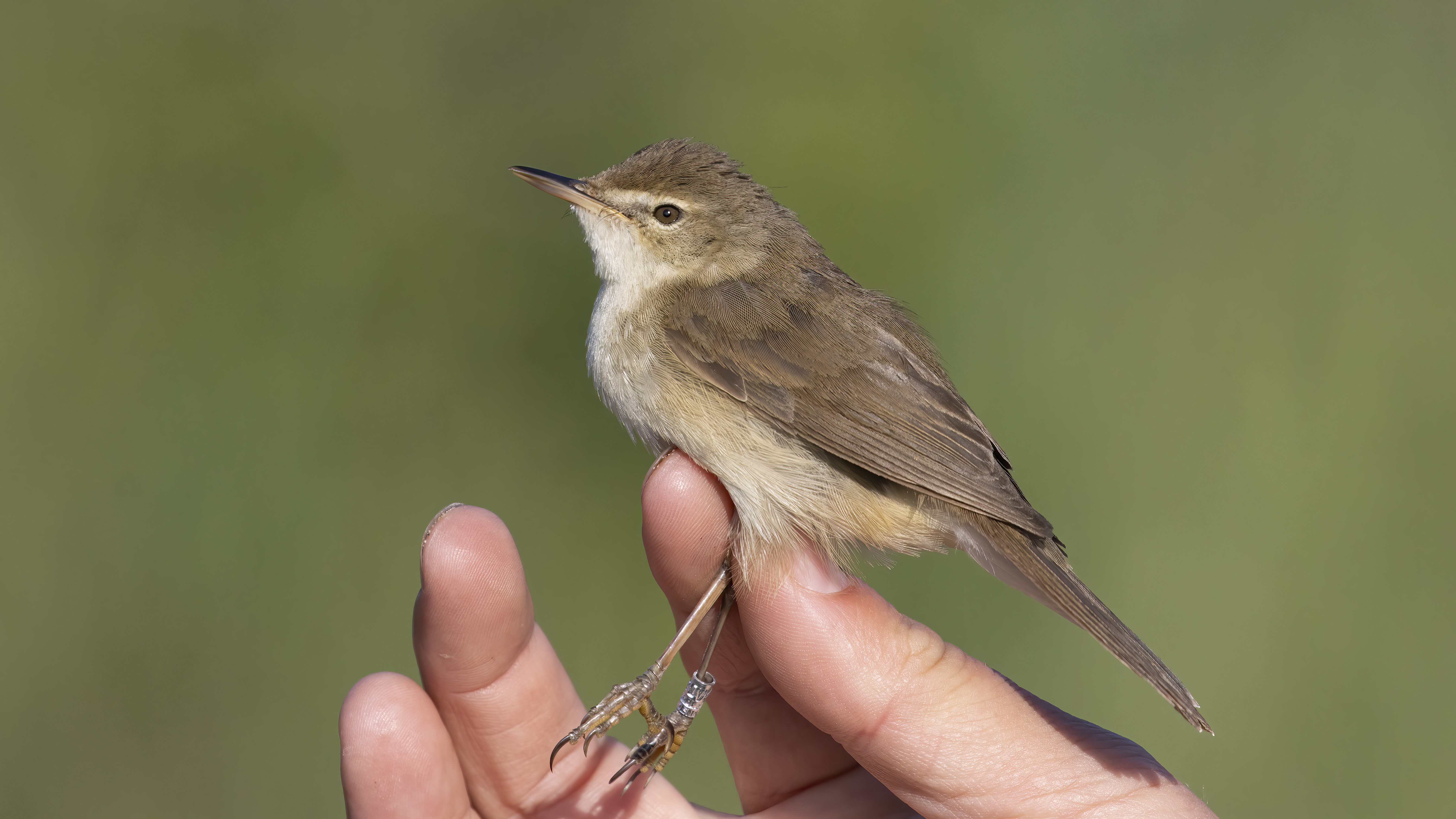 Buskrørsanger (Blyth's Reed Warbler). Foto: Knud Pedersen
Buskrørsanger (Blyth's Reed Warbler). Foto: Knud Pedersen
While us at Kabeltromlen were kept busy in the first hours of the morning, Skarvsøen struggled to catch as many birds. But they caught a 'weird looking Chiffchaff' - it was a Sibirisk Gransanger (Siberian Chiffchaff)! also an incredibly cool bird (but not a full species, so Kabeltromlen still got the cooler bird of the day). The CES session finished off with 15 ringed and recaptured birds. It's worth noting 6 of these were recpatures, which is a far higher rate of recaptured birds than at Kabeltromlen, which focusses on migratory birds.
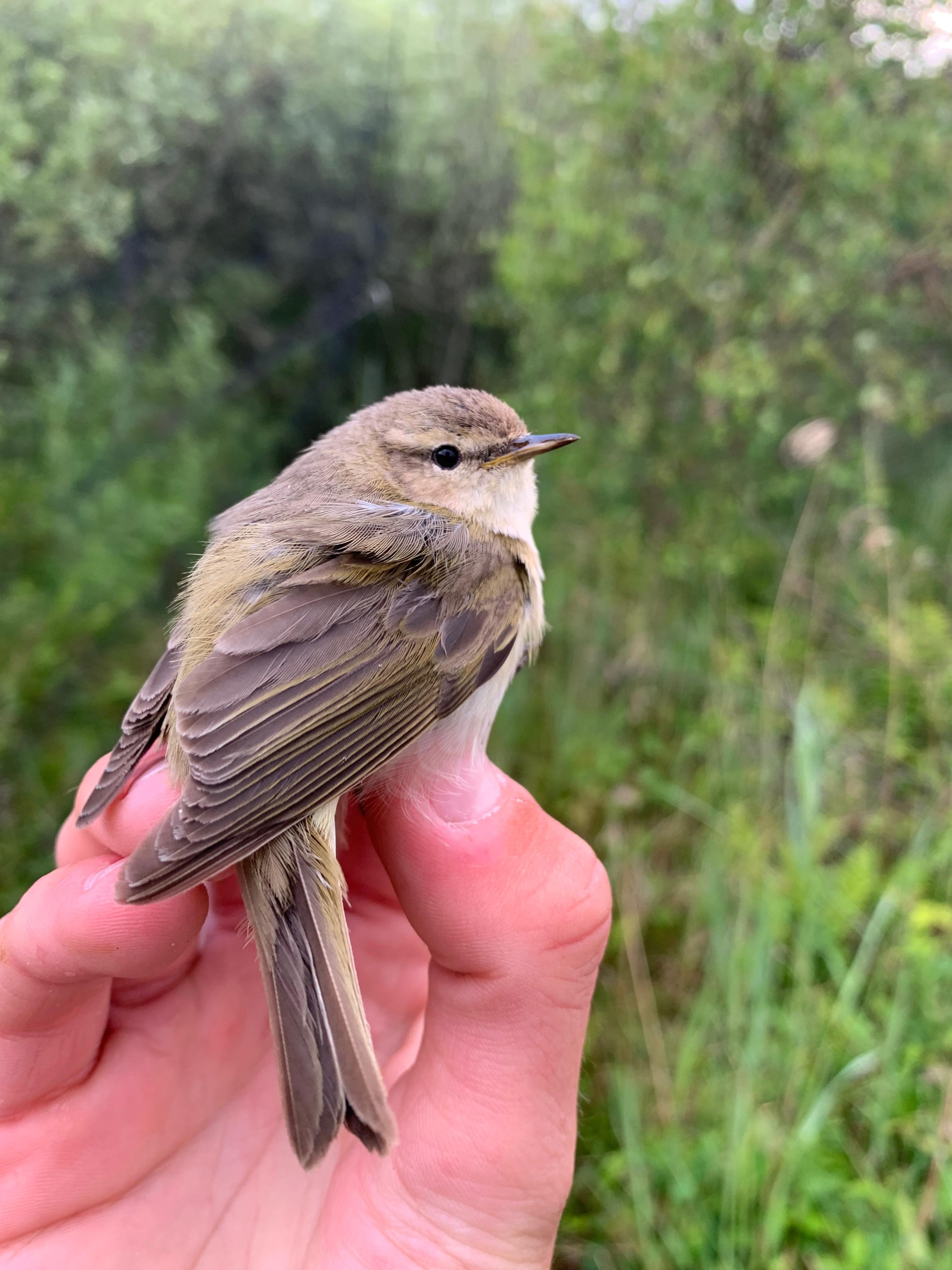
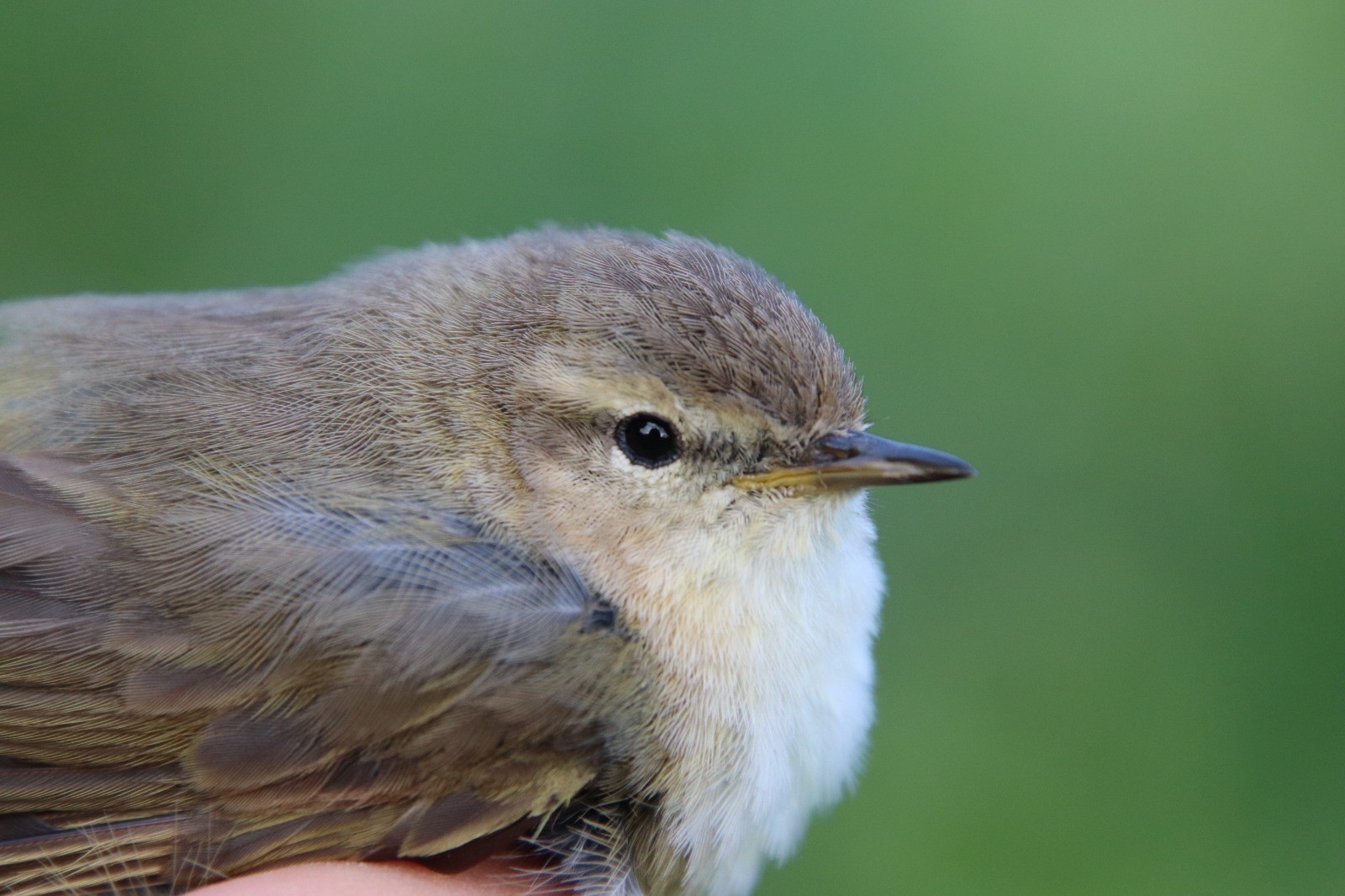 Sibirisk Gransanger (Siberian Chiffchaff)
Sibirisk Gransanger (Siberian Chiffchaff)
In observations news, there was a Brilleand (Surf Scoter) and a Amrikansk Sortand (Black Scoter) seen in the Skagerrak from Grenen today. There were very many Sortand (Common Scoter) in the Skagerrak too, with estimates by midday reaching minimums of 10,000 birds, more than twice the usual amount for the time of year.
Ringing (Kabeltromlen):
Redwing (Vindrossel) - 1
Reed Warbler (Rørsanger) - 2
Marsh Warbler (Kærsanger) - 3
Blyth's Reed Warbler (Buskrørsanger) - 1
Icterine Warbler (Gulbug) - 1
Chiffchaff (Gransanger) - 1
Blackcap (Munk) - 18
Garden Warbler (Havesanger) - 3
Chaffinch (Bogfinke) - 3
Total: 33
Ringing (Skarvsøen):
Chiffchaff (Gransanger) - 1
Siberian Chiffchaff, ssp. tristis (Sibirisk Gransanger) - 1
Reed Warbler (Rørsanger) - 2
Lesser Whitethroat (Gærdesager) - 1
Blackcap (Munk) - 3
Total: 8
Ringing (Fyrhaven):
Common Whitethroat (Tornsanger) - 1
Lesser Whitethroat (Gærdesanger) - 1
Total: 2
A link to today's observations from volunteers and local observers.
Sum of observations of raptors on DOFbasen from today.
People: Seán Walsh, Hayley Land, Isis Khalil, Magnus Houen Lauritsen, Simon Kiesé, Simon S. Christiansen, Henrik Knudsen, Karen-Marie and Søren Leth-Nissen, Hans Rytter, Tommy Kaae
Common Ringed Plovers
Magnus was the number one birder at World’s End 1 this morning, the only person to brave the wet and windy weather out there! Although it was generally very quiet with birds, he did see two Manx Shearwaters (Almindelig Skråpe), a new life species of him.
A bit later in the morning, when the rain had stopped, Søren kindly gave Simon Jr, Isis, Karen-Marie and I a lift to Gammel Skagen where we started the 10km Fulmar (Mallemuk) survey along the beach all the way back to Det Grå Fyr. We were looking for dead Fulmars (Mallemuk) to collect for Aarhus University where the stomachs will be analysed for their plastic content.
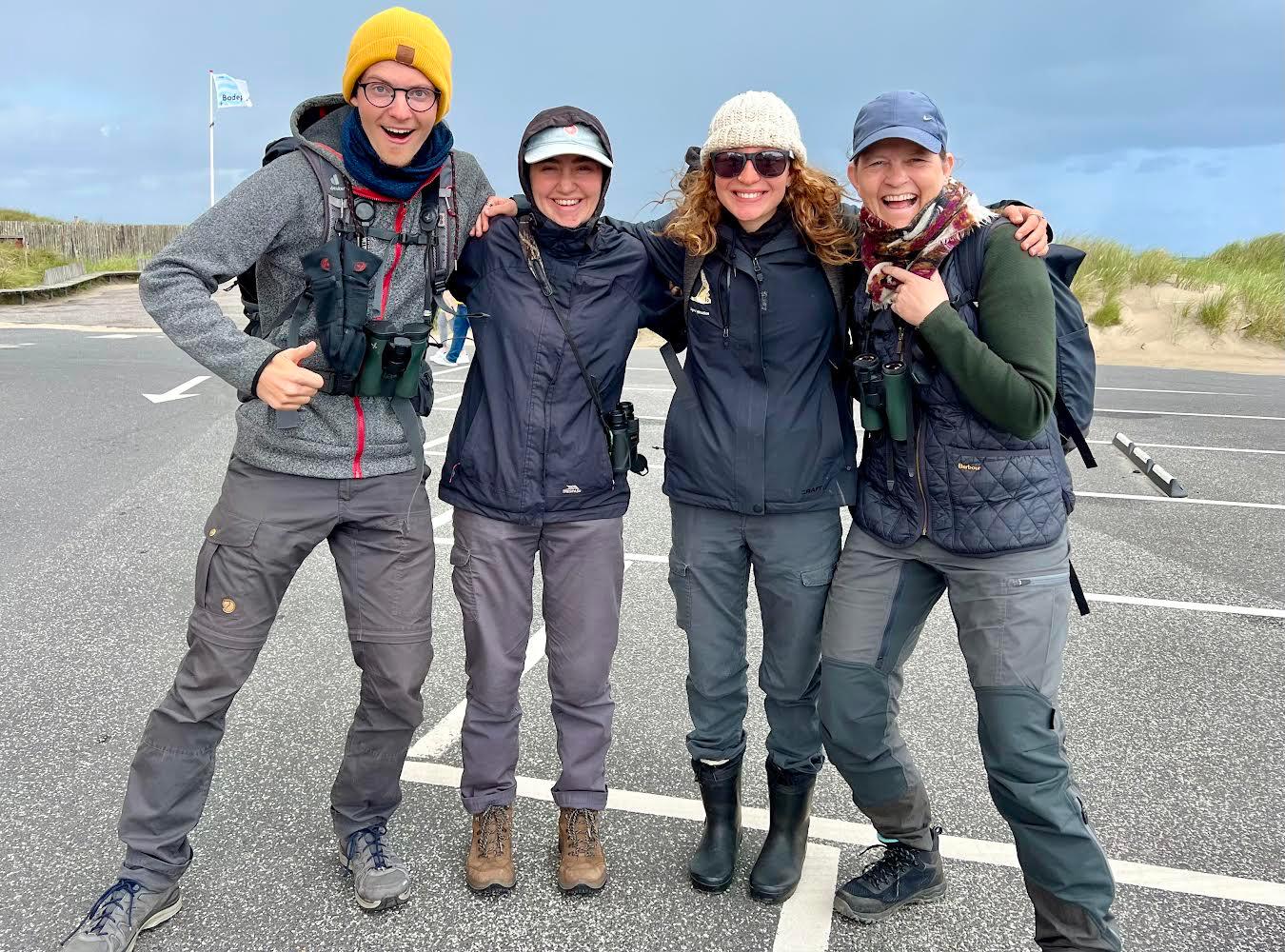
Fulmar survey team. Photo by Søren Leth-Nissen
Unfortunately, we didn’t find any Fulmars (Mallemuk) this time but we did find some onions which were great for a spontaneous game of football on the beach!
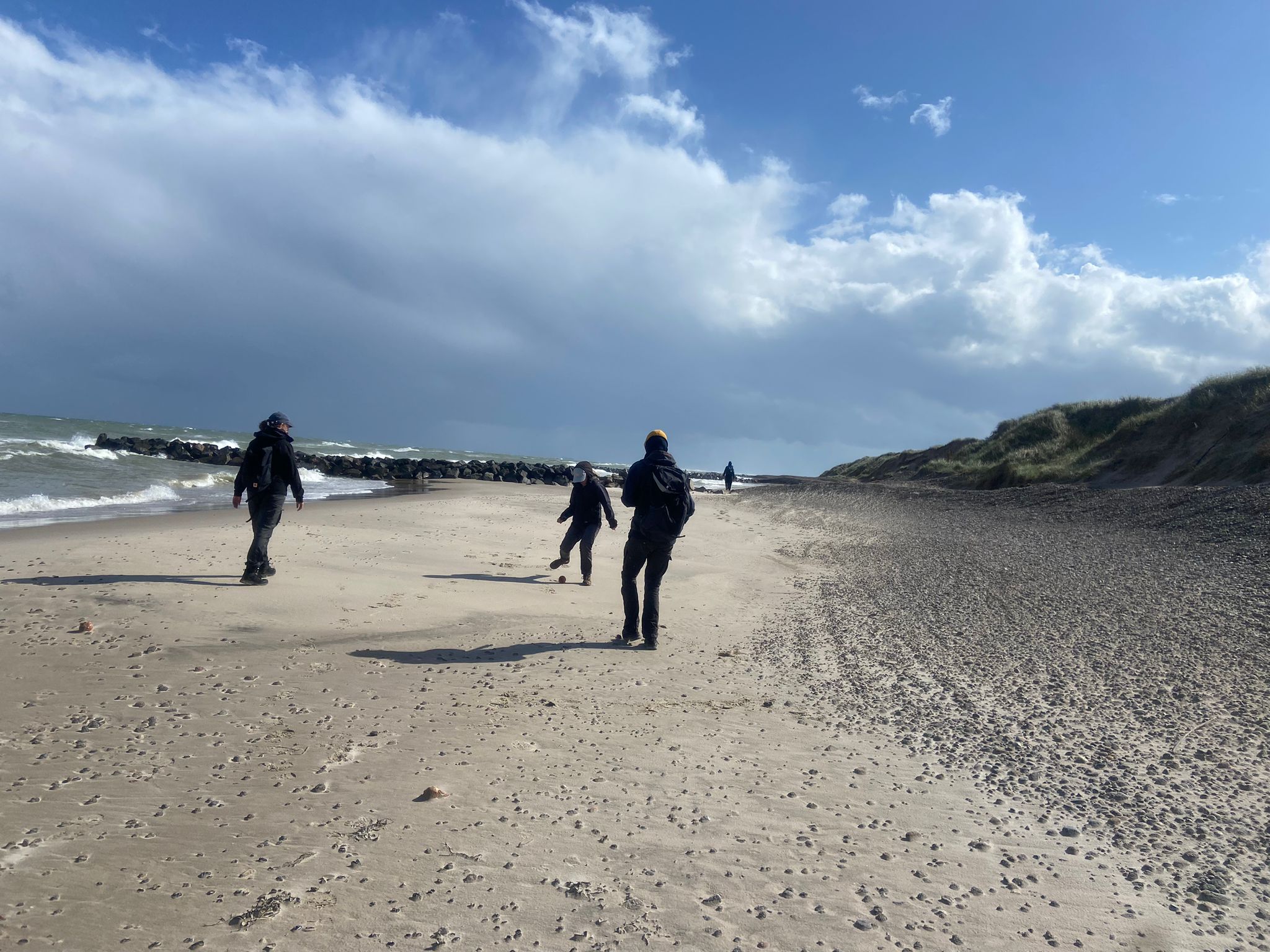
The walk was very wild and windy with bright sunshine and a very dramatic sea. We saw several pairs of Common Ringed Plovers (Stor Præstekrave); these are the only wader species breeding along the beach here and we were lucky enough to see three cute little chicks running around near the dunes.
Later in the afternoon we returned to Nordstrand with steel rings and ringing equipment and walked back along the beach to where we had seen the chicks. We found them again within ten metres of where they had been in the morning and the three cute little balls of fluff each got themselves a shiny new ring.
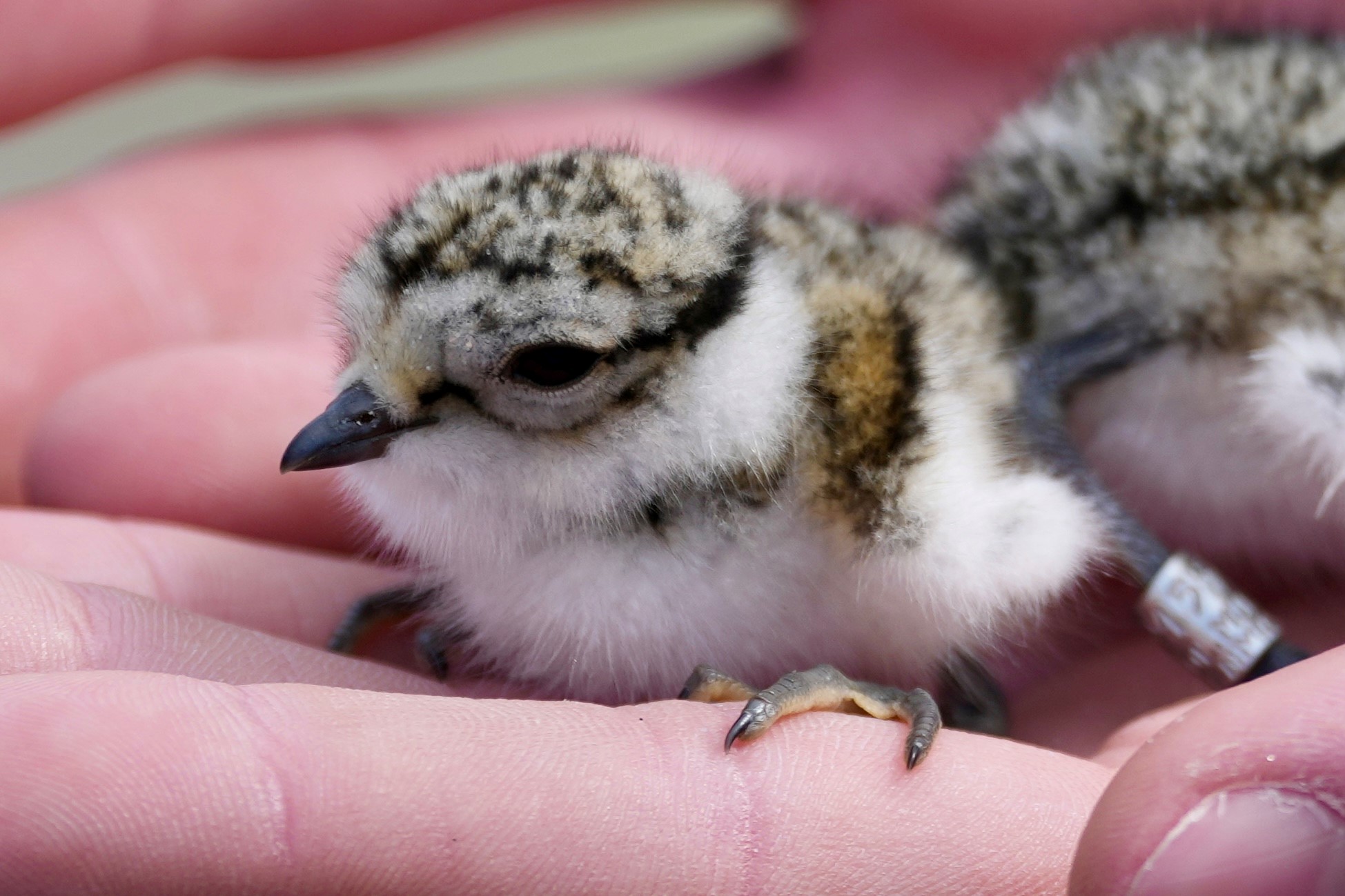
Common Ringed Plover (Stor Præstekrave) chick. Photo by Søren Leth-Nissen.
The adults remained close by and watched as we quickly and carefully ringed the chicks. It was interesting to watch their behaviour and how they try to distract potential threats away from their chicks.
Simon Jr also found a Common Ringed Plover (Stor Præstekrave) nest. You can see how well camouflaged the eggs are in the photo below.
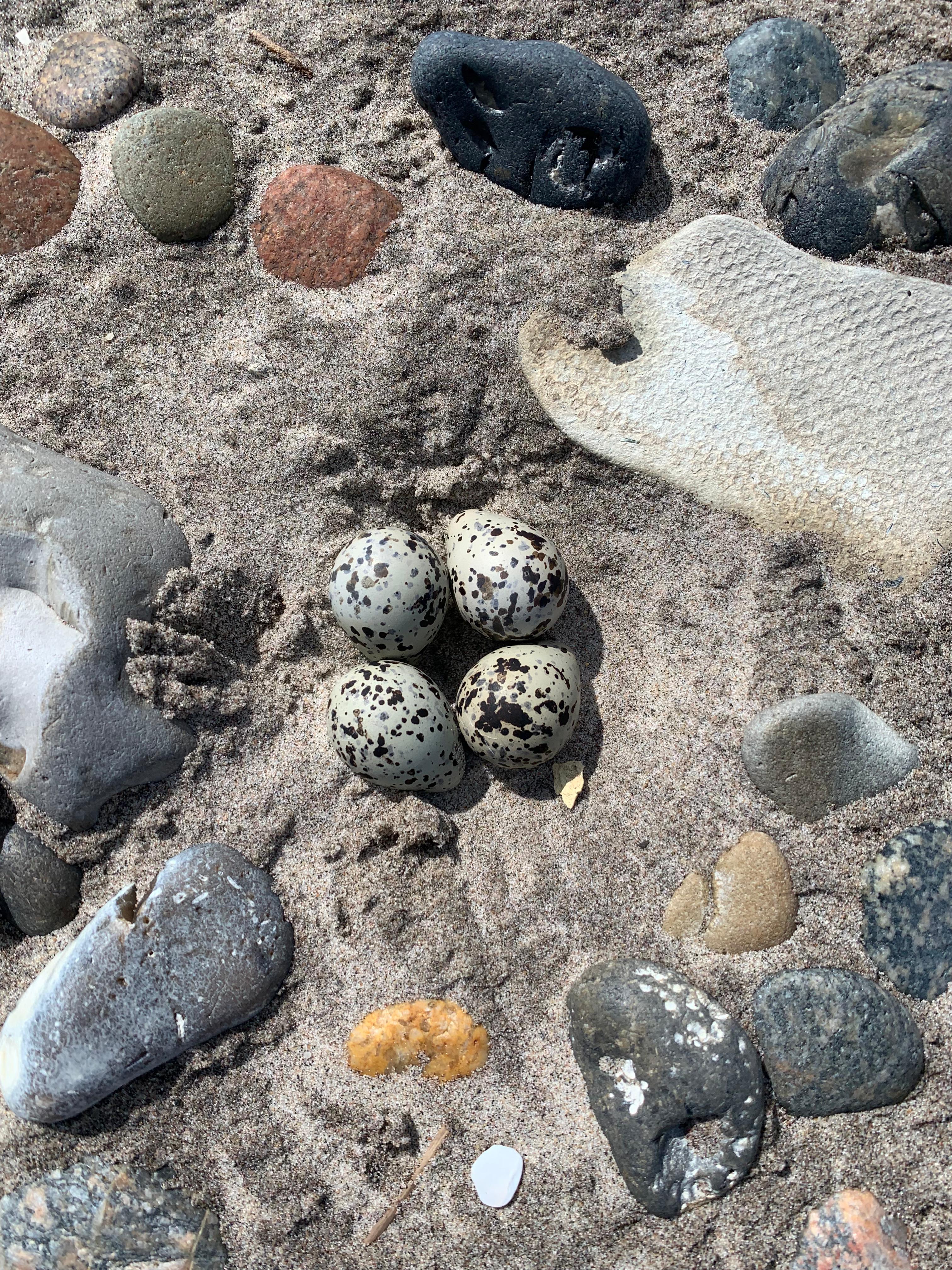
Common Ringed Plover (Stor Præstekrave) nest
On our way back to the lighthouse we were treated to an absolutely amazing view of the Steppe Eagle (Steppeørn) flying right over our heads. It was so close that we had to duck! Søren got some incredible photos as it passed over us.
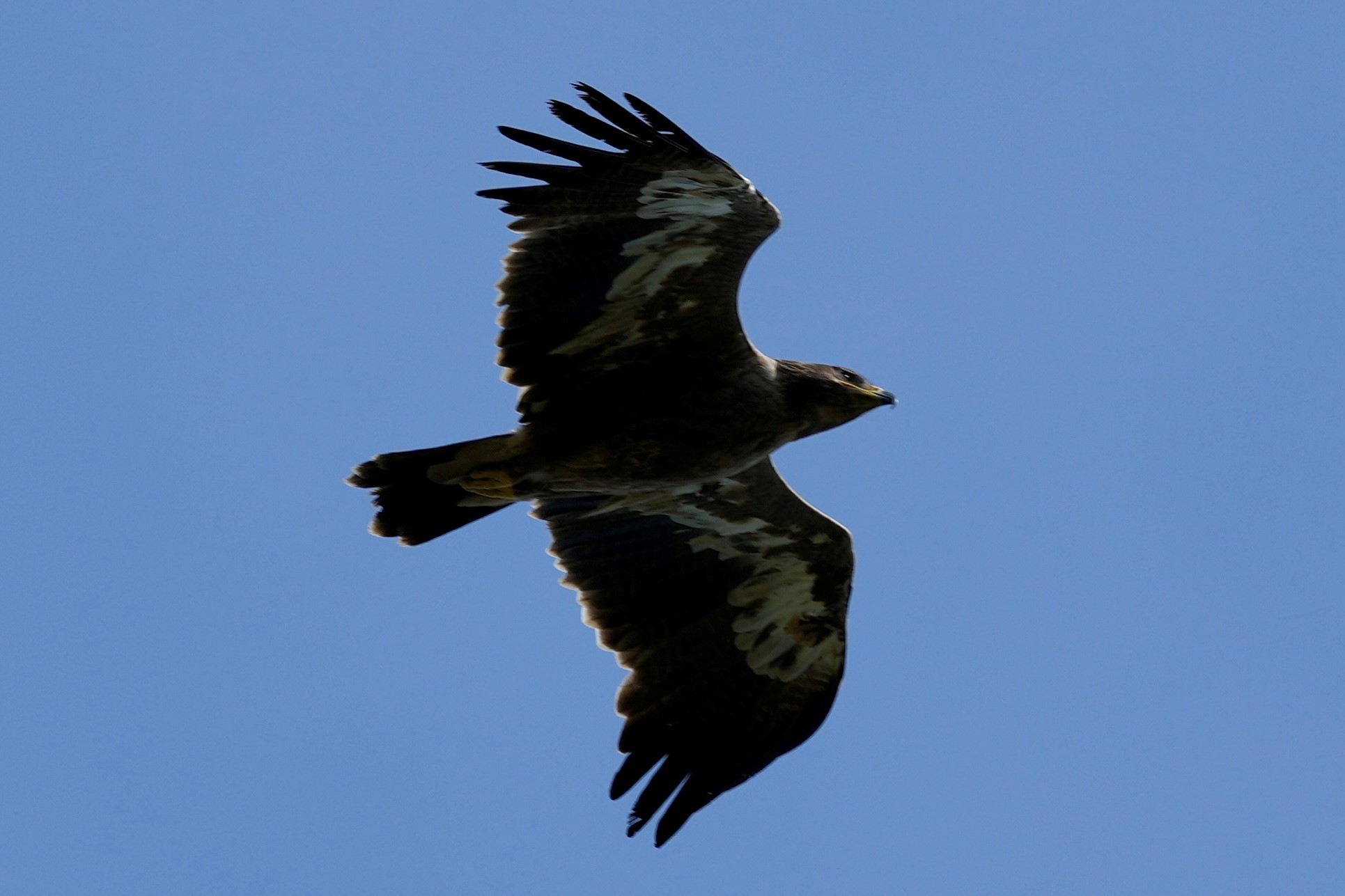
Steppe Eagle (Steppeørn). Photo by Søren Leth-Nissen.
We returned to the station just in time to celebrate Constitution Day with Magnus and his family. They brought delicious bread and cake and we had a great time celebrating altogether in the garden.
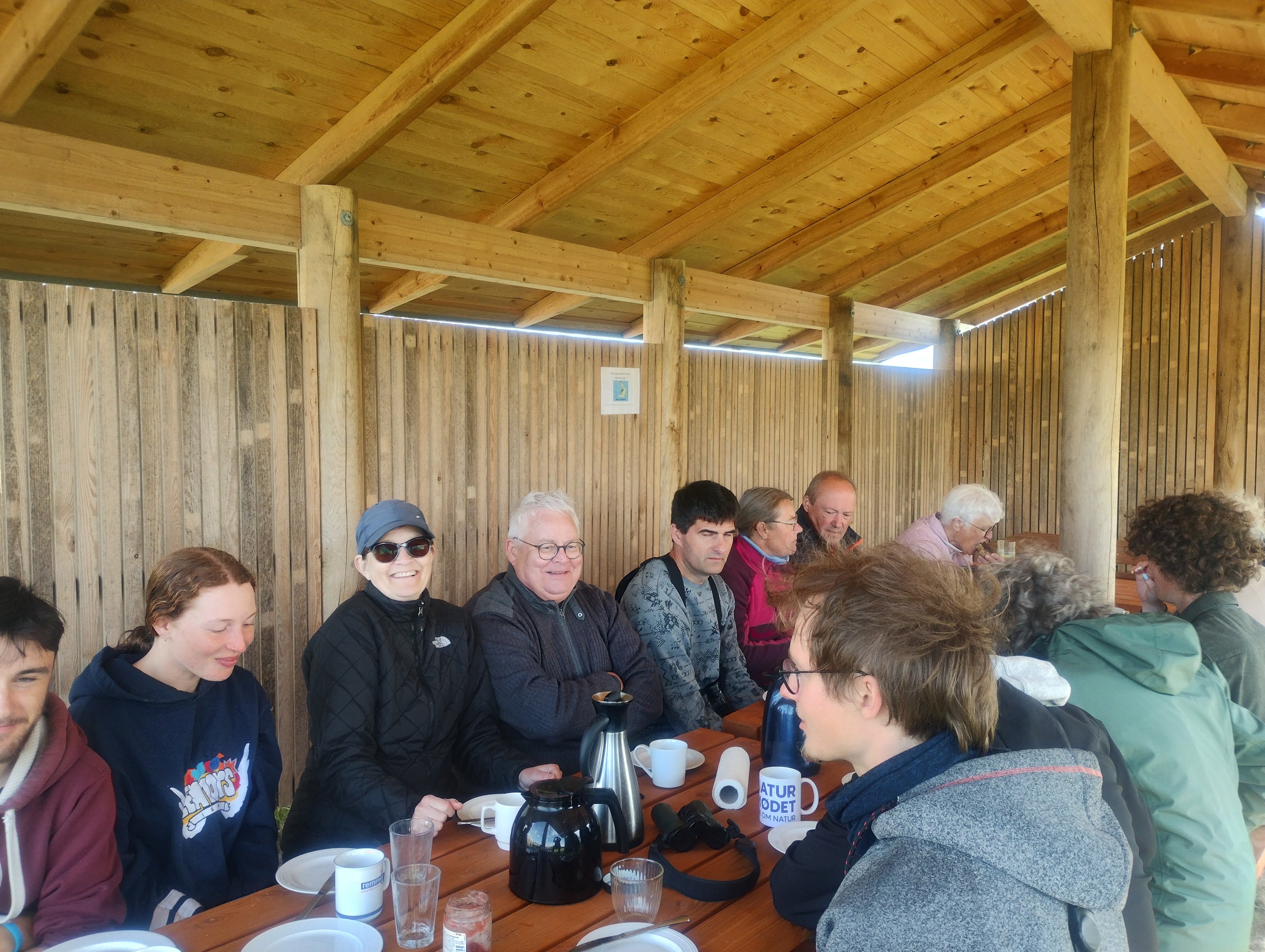
Søren and Karen-Marie are now cooking our dinner; it already smells delicious!
Ringing (Nordstrand):
Common Ringed Plover (Stor Præstekrave) – 3
Total: 3
Today’s observations in Dofbasen from observers in the area.
Sum of the raptors in the area based on observations typed into Dofbasen the same day.
People: Seán Walsh, Hayley Land, Isis Khalil, Magnus Houen Lauritsen, Simon Kiesé, Simon S. Christiansen, Karen-Marie and Søren Leth-Nissen.
Fulmars and the last Harrier migration
Simon and I woke up by 03.30. Sunrise these days are around 04.20. And due to the lack of bikes, I have to leave 15 minutes earlier than the rest of the volunteers to make it in time for sunrise. We headed for WE1, where three birders had already arrived. The amount of mosquitoes has lowered significantly to a more tolerable level.
The migration of Canada Goose is at it’s highest right now. We usually have a few hundreds during the day. Today was an exception, though. We only had four individuals. And they even headed in the wrong direction! But not even the direction was strange. One of the individuals was as well. It was clearly smaller than the rest. Approximately only ¾ the size of a normal Canada Goose. So maybe a subspecies or a escaped Cackling Goose.
What might be the last Montagus harrier of spring showed up as well. Otherwise, it is clear to everyone, that spring-migration already has passed by, and autumn migration kind of already has begun.
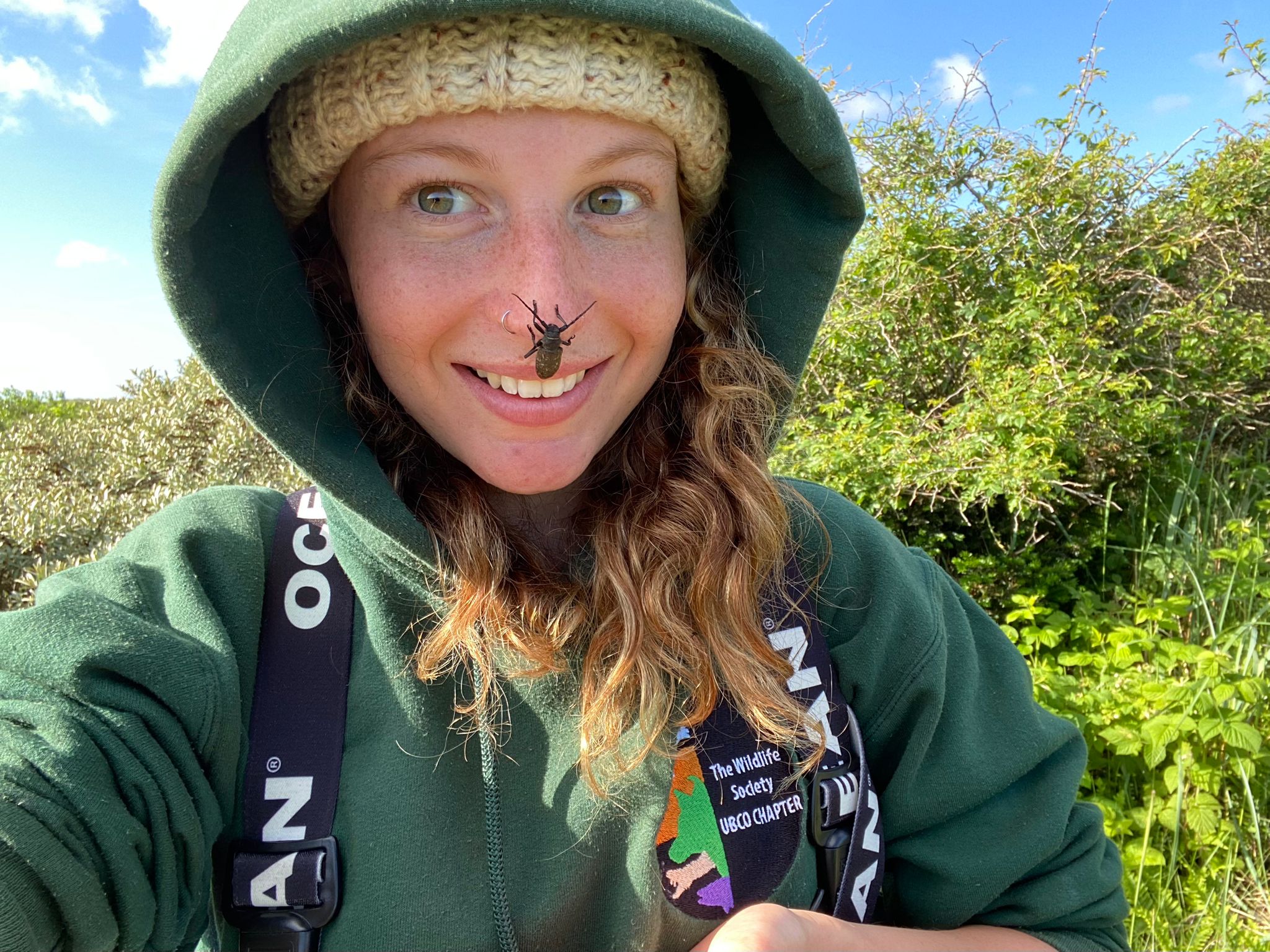
Isis with a Væver/Weaver Beetle (Lamia textor). Photo: Isis Khalil
It was rather slow in the ringing as well. A late redwing were among the birds. A total of 16 birds were ringed. Half of them black caps.
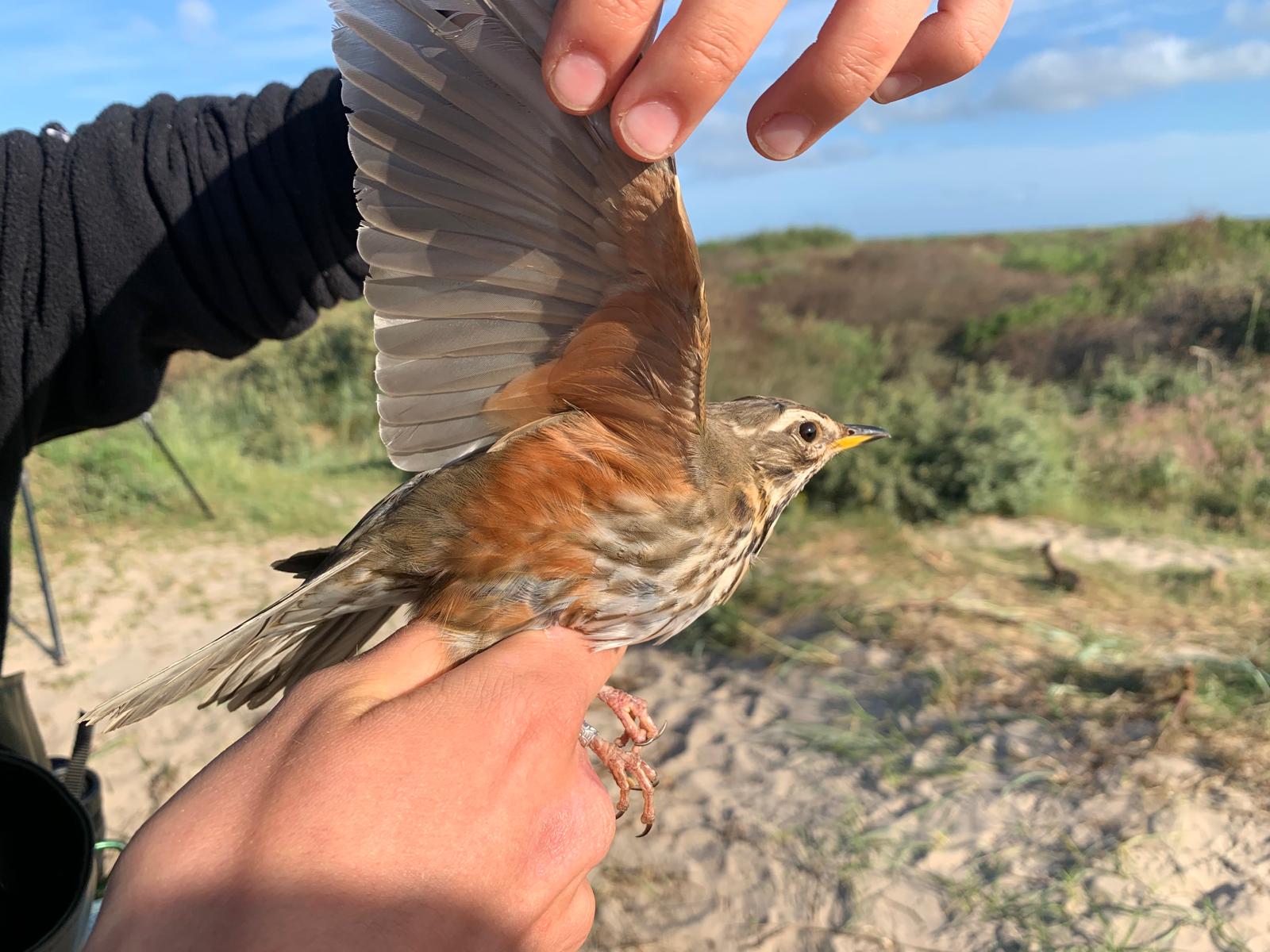
Red wing. Photo: Isis Khalil
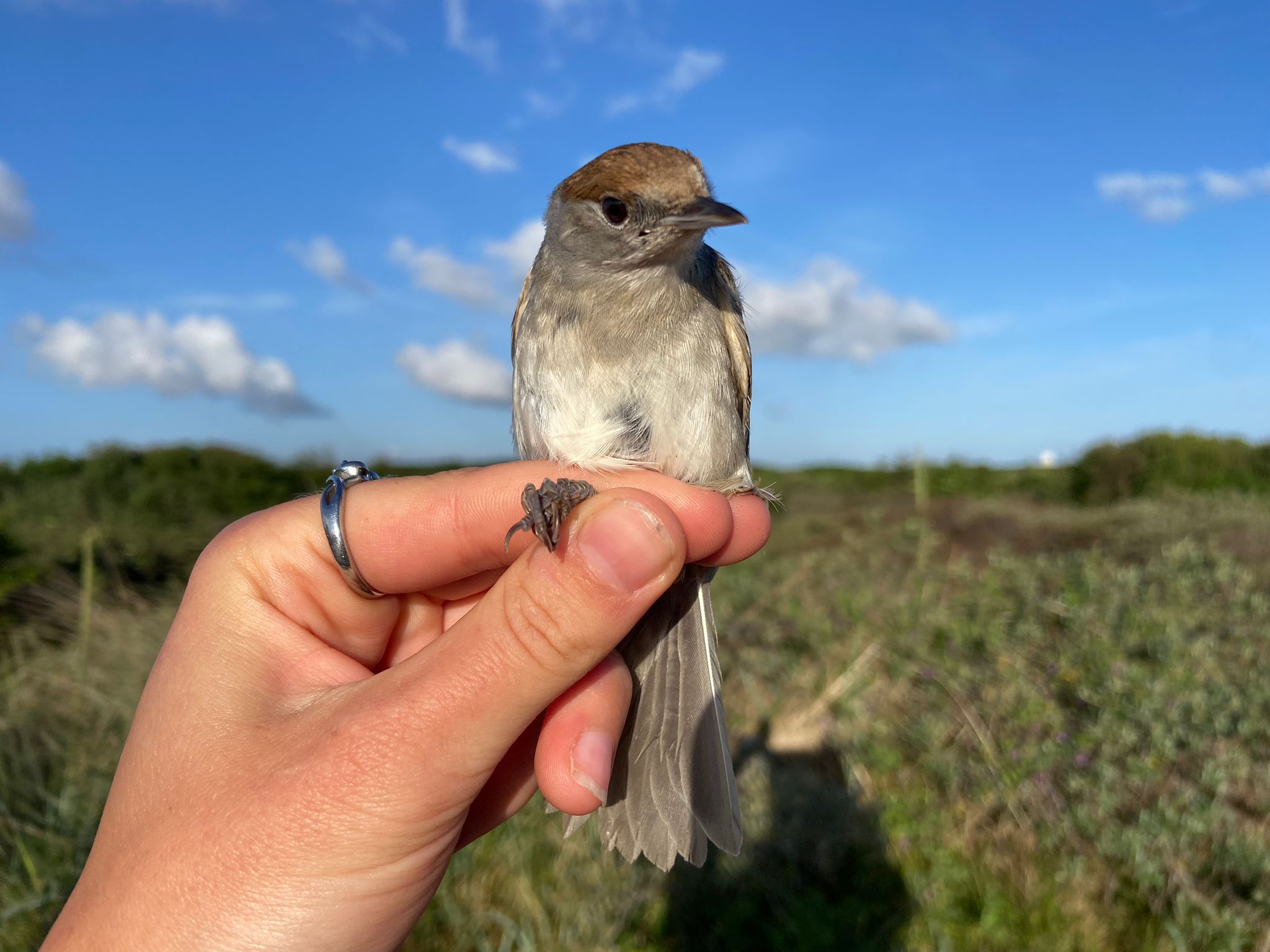
One of the many black caps. Photo: Isis Khalil
Ringing (Kabeltromlekrattet):
| Wren | Gærdesmutte | 1 |
| Red Wing | Vindrossel | 1 |
| Reed Warbler | Rørsanger | 2 |
| Bullfinch | Dompap | 1 |
| Common Whitethroat | Tornsanger | 2 |
| Garden Warbler | Havesanger | 2 |
| Blackcap | Munk | 8 |
Total: 17
Today’s observations in Dofbasen from observers in the area.
Sum of the raptors in the area based on observations typed into Dofbasen the same day.
People: Hayley Land, Isis Khalil, Magnus Houen Lauritsen, Seán Walsh, Simon Kiesé, Simon S. Christiansen, Henrik Knudsen, Karen-Marie and Søren Leth-Nissen, Knud Pedersen.
Vi Ses, Jørgen Hulbæk!
Howdy y’all, it is an honour to finally bring to you our daily blog as scheduled, although there are still some wifi issues at the lighthouse. Today was bittersweet in every which way, on one hand, the mosquitoes were blown away by the wind (god bless!), on the other hand, we lost our legendary Cake Man, expert birder, and kind Dane: the one and only Jørgen Hulbæk. We all wish him the best of luck in his migration back to Copenhagen, though his absence will be felt heavily here.
Departure gifts from Jørgen Hulbæk, mange tak Jørgen!
As for ringing, the numbers were okay, and the day passed by very fast. There were no crazy species, but we enjoyed a very late (and quite sick) Redwing (Vindrossel).
Opening the nets.
Hayley caught a Blackbird (Solsort) she had ringed last autumn, which was also a very cute surprise!
Hayley with her Blackbird (Solsort).
We were also joined in the field by our guests Karen-Marie and Søren Leth-Nissen at Kabeltromlen, Karen-Marie even helped with ringing! She got to ring 3 Eurasian Blackcaps (Munk). I think they’re a wonderful species, especially to practice with, since they are a nice size and have a very calm personality. So we had plenty of fun regardless of the lack of variety in species!
I also stumbled upon the cutest little Newt today, we named him Isaac.
Isaac NEWTon. Smooth Newt - Lissotriton vulgaris (or Lille Vandsalamander in Danish).
At the count, there was also nothing in particular worth mentioning. Their highlights were high numbers of Northern Fulmars (Mallemuk) and a Montagu’s Harrier (Hedehøg).
When we got back to the station, we indulged in two traditional forms of herring on rye bread (thank you Magnus). They were very delicious, though I definitely prefer the curry sauce method. Then we had some pineapple, which was also delicious!
Magnus cutting the pineapple.
So overall, our day was not very interesting bird-wise, but we definitely had a lot of delicious things to remember.
In the evening, we made an effort to catch up on all our data entry and blog posts which we’ve fallen behind on due to the lack of internet. We also heard from Simon (Sr) that Jan Eske and our guests made generous donations to our food collective today, mange tak! We will be sure to use your donations for good purposes, and we will continue to work hard!
Simon (Sr) also brought Colin McShane and his wife to the station, they were both very kind. Colin tags Jack Snipes (Enkeltbekkasin) in the UK, which is very interesting! You can find some footage of the region where he works in you search Jack Snipe Winterwatch into Youtube. (I have also linked to his video in this sentence).
At the evening meeting we were joined by Lars Yttte, Morten Christensen, our guests, and the SKAF team, so our little living room felt very lively and full. We planned our trip to Hirtshals and shared about our days, as well as preparing for the field tasks we need to complete throughout the week.
That’s all I have for you today!
Skifte.
Ringing (Kabeltromlekrattet)
Reed Warbler (Rørsanger) - 1
Eurasian Blackcap (Munk) - 10
Lesser Whitethroat (Gærdesanger) - 1
Marsh Warbler (Kærsanger) - 2
Icterine Warbler (Gulbug) - 1
Common Whitethroat (Tornsanger) - 1
Redwing (Vindrossel) - 1
Willow Warbler (Løvsanger) - 1
Total: 18
Today’s observations in Dofbasen from observers in the area.
Sum of the raptors in the area based on observations typed into Dofbasen the same day.
People: Seán Walsh, Hayley Land, Isis Khalil, Magnus Houen Lauritsen, Simon Kiesé, Simon S. Christiansen, Jørgen Hulbæk, Karen-Marie and Søren Leth-Nissen, Jan Eske, Lars Yttte and Morten Christensen
Enjoying the Skagen jungle
In the jungle, the Skagen jungle, the volunteers did not sleep tonight.
In the jungle, the Grenen jungle, the volunteers went out early in the morning.
Auuuuuuuuuuuuueeeaaaaeeaaaeaaambaammbaaaeeeeeeeee.
At 3.55 am I looked on the time and all nets are opened, another day in Skagen starts. The first round in the ringing was pretty fine and several Blackcaps (Munk) showed up. Even if the numbers lowered during the morning, some more Garden Warblers (Havesanger) got a new ring. In the last round two Lesser Redpolls (Lille Gråsisken) surprised us. Since there were not so many birds, we could spend some more time on looking on the extend of the moult of some of the birds.
In the meanwhile, the count was not really better, but since Skagen is a great spot for birding, there are still good birds around. The highlight was a Red-breasted Flycatcher (Lille Fluesnapper) calling at World’s End 1. Four Arctic Skuas (Almindelig Kjove), Corn Bunting (Bomlærke), Black-thorated Divers (Sortstrubet Loms), Rosefinchs (Karmindompap) and again a late Brambling (Kvækerfinke) show, that there are always good birds around. Later some Honey Buzzards (Hvepsevåge) passed by very lose, so beautiful!
In the afternoon, we met Simon Sr. in town at a Café and had nice Icecream/Icecoffee. That was really chilled. Then I put my letter for the EU-parlament-elections in the mail box and we went shopping. We bought a Pineapple, that was another highlight of this calm and sunny day. It is the best food when it is so warm like today. Isis prepared nice Kebap for dinner and it was really really really tasty. I’m not kidding. It was amazing, the best stuff I have eaten for a long while. Afterwards Karen-Marie and Søren – our new guests in the apartment – arrived. Hayley, Seán and and I knew them before, so it was great to see them again. Really nice people! Tomorrow there will be some westerly winds. The change in wind is very interesting and it can bring some good birds, but it can also be a bit slow. Let’s hope the best, we will be out in anyway and hope for some nice surprises. Since the WiFi is not working at the moment, data entery is a bit hard at the moment. At least the blog is online now, so we can enjoy the last sunlight outside before we fall into our bed. Station’s life is fun!
Ringing totals can not be added right now due to wifi problems. The highlights are mentioned in the blog in anyway. ;-)
Today’s observations in Dofbasen from observers in the area.
Sum of the raptors in the area based on observations typed into Dofbasen the same day.
People: Seán Walsh, Hayley Land, Isis Khalil, Magnus Houen Lauritsen, Simon Kiesé, Simon S. Christiansen, Jørn and Marianne, Karen-Marie and Søren Leth-Nissen.
We like June!
When Simon Sr joined us at Kabeltromlen early this morning he told us that June is usually a very good month for rare birds in the ringing. With that in mind, we set off on our next round with renewed excitement for the upcoming days. What we weren’t expecting was for Simon to be proven correct so quickly. On that very round Sean found a Greenish Warbler (Lundsanger) in one of the nets!
We were all very happy to catch this pretty little warbler, only the fourth ever individual to be caught by the station. You can clearly see the white wing bar and prominent supercilium (eye stripe) in the pictures below.
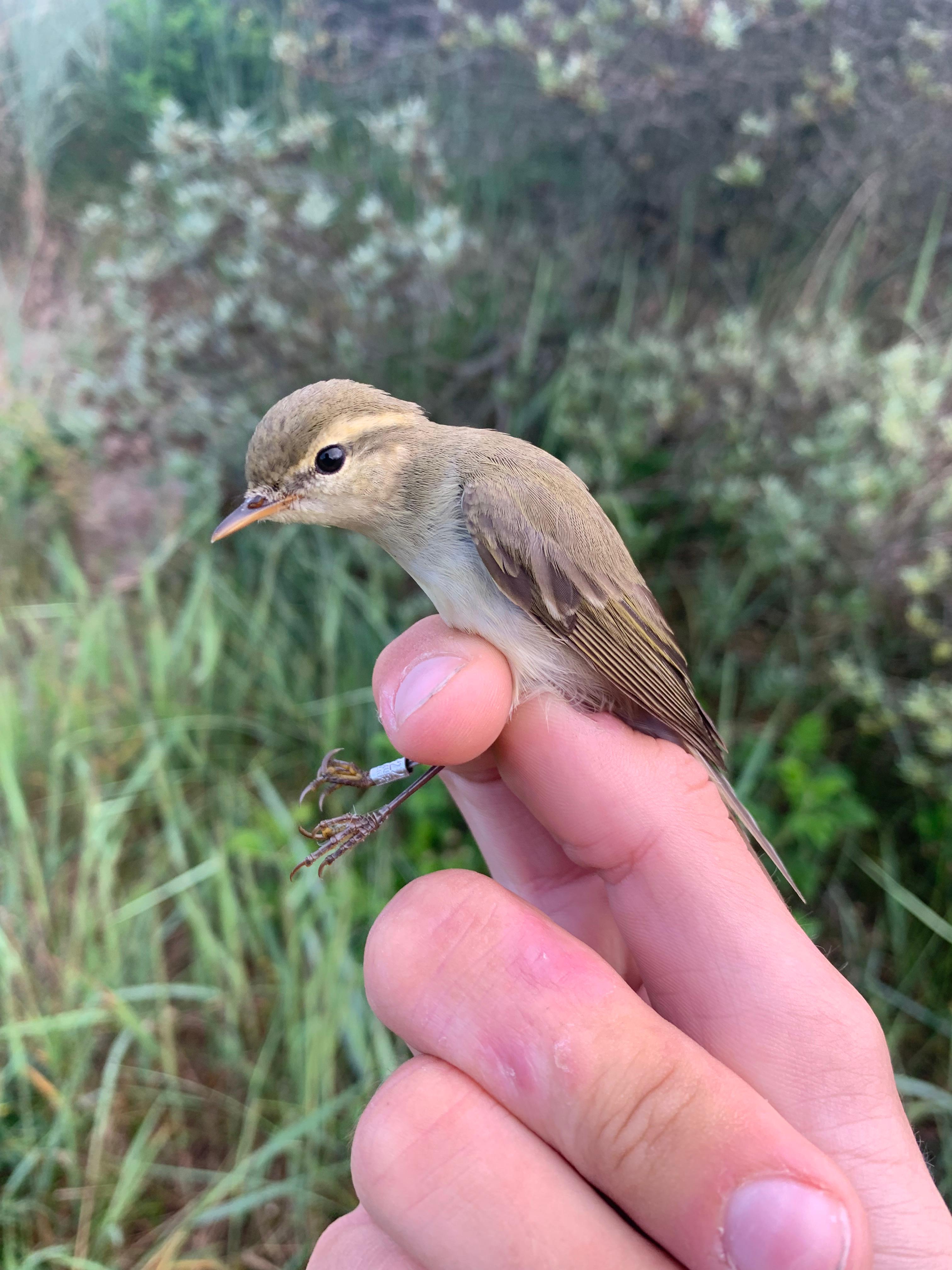
Greenish Warbler (Lundsanger)
After that, we decided that we already liked June a lot. And this month’s good luck didn’t end there! On our closing round Isis extracted a Rosefinch (Karmindompap), a new hand species for us all. Not much is known about the moult of this species so they cannot be aged. Although our bird wasn’t a bright red adult male, it was still a very pretty individual. Amazingly, these birds fly all the way from south-east Asia where their wintering grounds are.
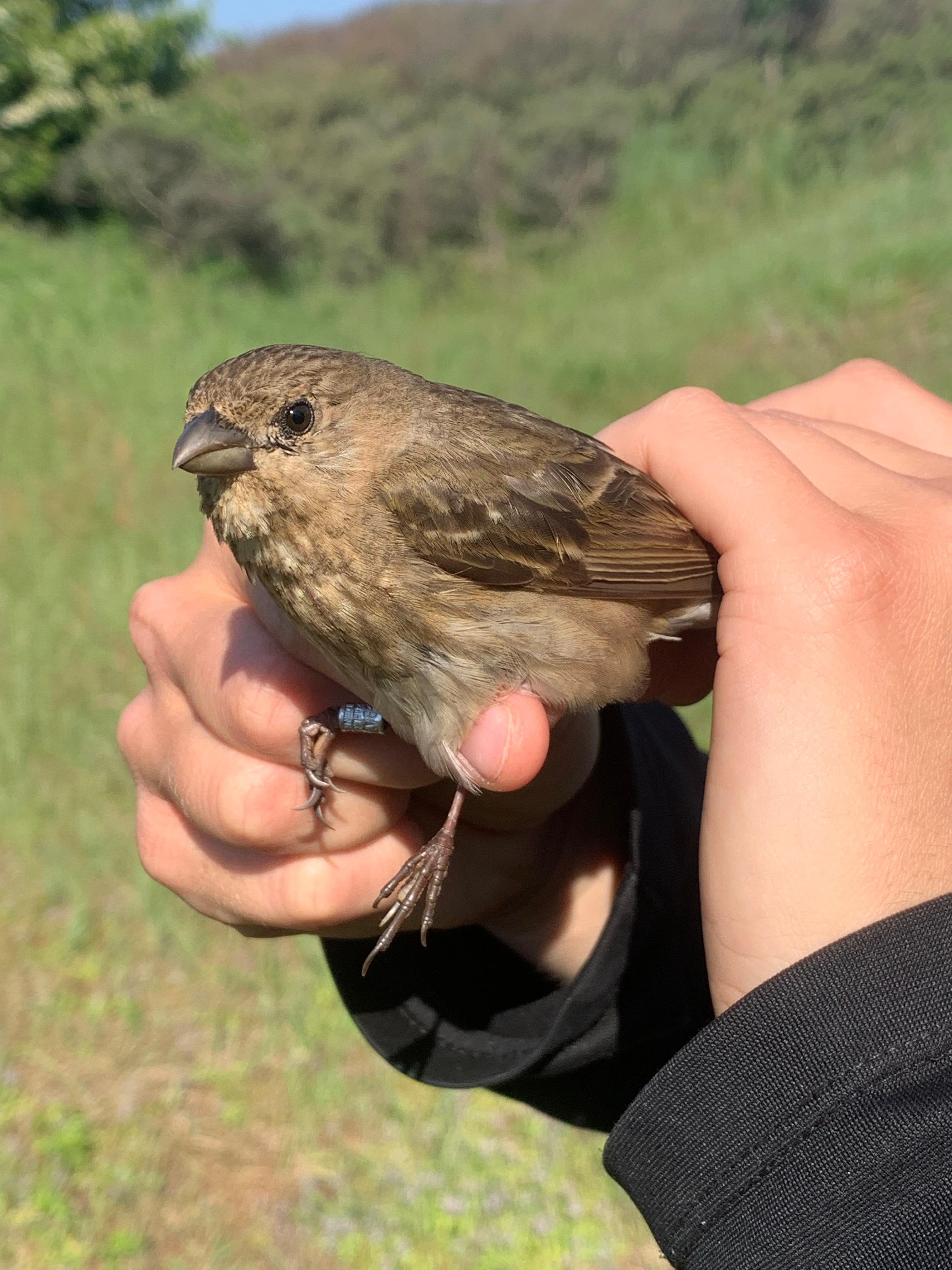
Rosefinch (Karmindompap)
After the Rosefinch (Karmindompap), we all decided we really really liked June. Hopefully today’s birds will be the first of many more ringing rarities this month! We’re really looking forward to what the next few days may bring.
We arrived back at the station in time to grab some snacks and then sit on the front steps and watch the Svogerslev Harmoniorkester performing. It was very nice to listen to them play their music out in the sunshine whilst drinking coffee (tak Mette!). We particularly enjoyed ‘can you feel the love tonight’ from the Lion King.
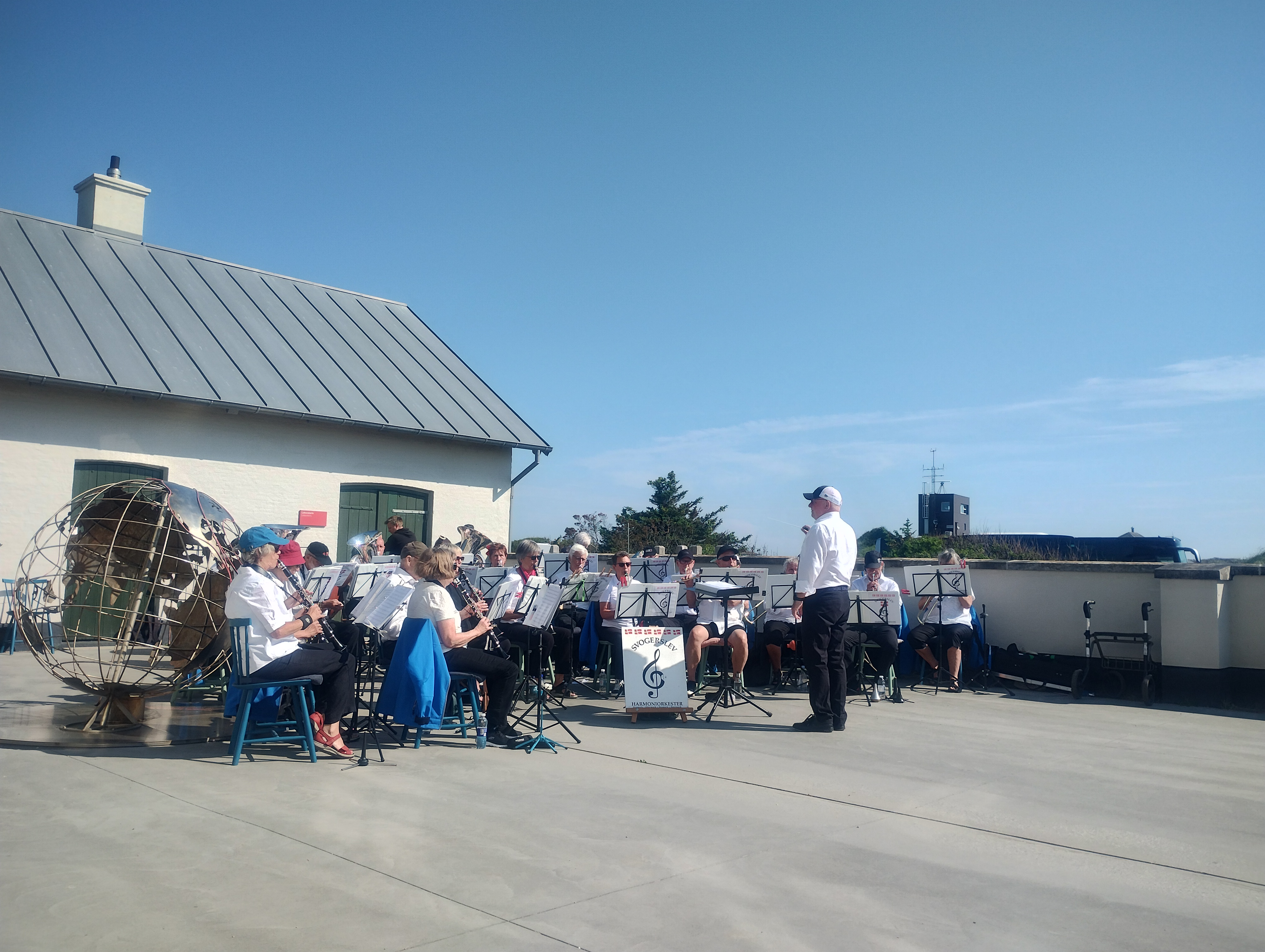
Svogerslev Harmoniorkester
Afterwards, Jens from the lighthouse appeared with a bubble machine which was lots of fun. There were so many bubbles everywhere!
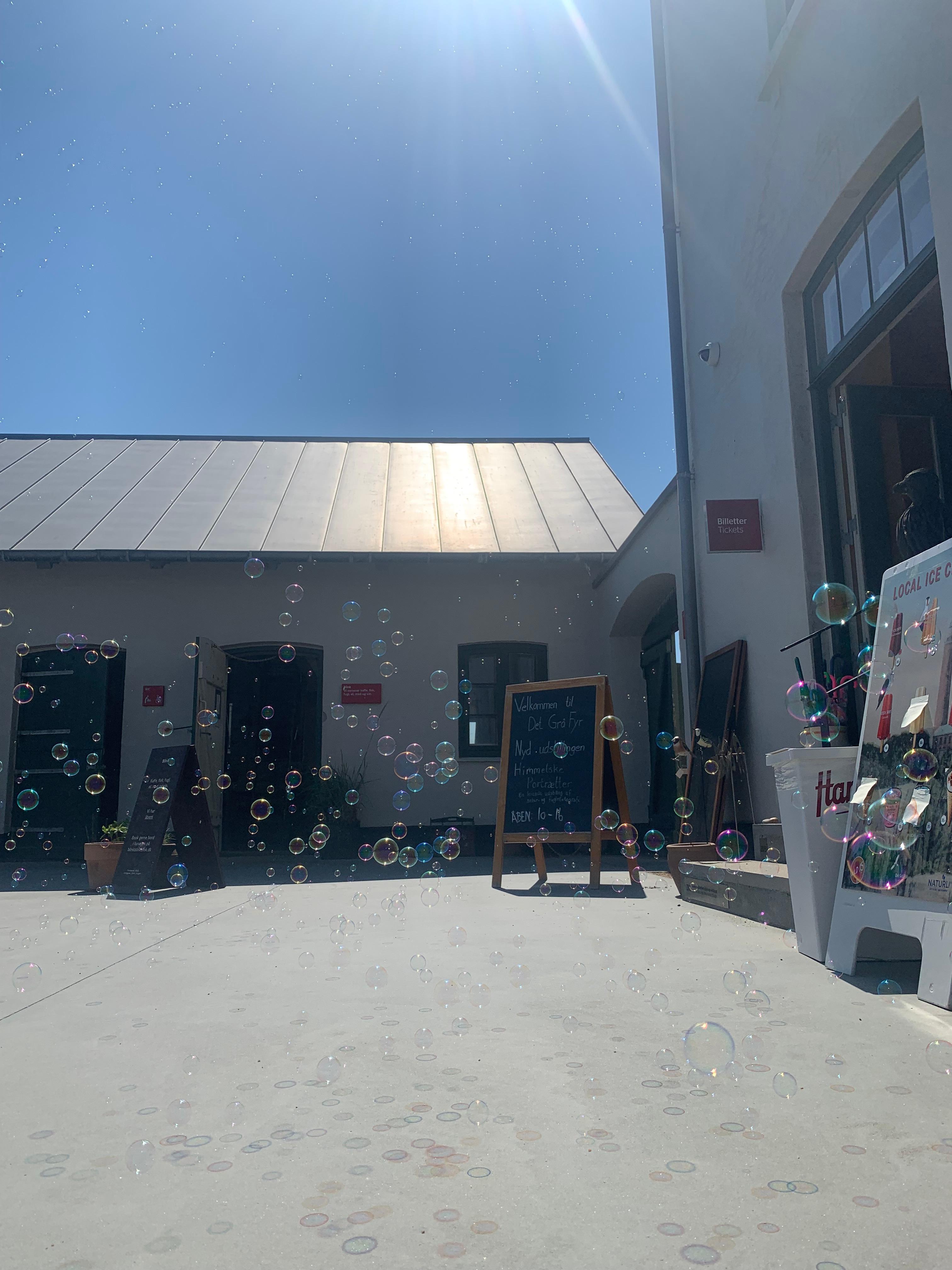
We then had to focus on some actual work; data was inputted and the weekly cleaning completed. We have also found out that the Swedish ringed Sedge Warbler (Sivsanger) that we caught earlier this week was originally ringed in Järnbron, Sweden in September 2023 as a first calendar year bird.
What a great start to June!
Ringing (Kabeltromlekrattet):
| Wren | Gærdesmutte | 1 |
| Sedge Warbler | Sivsanger | 1 |
| Marsh Warbler | Kærsanger | 1 |
| Reed Warbler | Rørsanger | 5 |
| Lesser Whitethroat | Gærdesanger | 5 |
| Common Whitethroat | Tornsanger | 5 |
| Garden Warbler | Havesanger | 6 |
| Blackcap | Munk | 5 |
| Greenish Warbler | 1 | |
| Rosefinch | Karmindompap | 1 |
Total: 31
Today’s observations in Dofbasen from observers in the area.
Sum of the raptors in the area based on observations typed into Dofbasen the same day.
People: Seán Walsh, Hayley Land, Isis Khalil, Magnus Houen Lauritsen, Simon Kiesé, Simon S. Christiansen, Jørn and Marianne.
Black Cap and Marsh Warbler galore in the ringing
I got up for counting on my own at 03.25 - an hour before sunrise. I because of the recently lack of bikes, I have to leave a bit earlier. I arrived around sunrise at Worlds End 1, as the 3rd person. To my big surprise, the talented german (SK) arrived just a minute later, to join me in the count. Even Though the migration is almost done, we always hope for a rarity to show up. Unfortunately, nothing really happened, and it turned out to be the ringing that had the best numbers of the day, with 11 Black Caps and four Marsh Warblers as the best.
Simon and I joined the rest of the volunteers at Kabeltromlen when the count was done. Simon stayed until the ringing was done an hour later, and I for two hours, because I started chatting with Henrik Knudsen and Ole Zoltan Göller. They told me stories from way back. Before Zello was invented. Back when there was no electricity in regular houses, and they had to dig themselves out through 2-3 kilometres of snow to the nearest road to go shopping by foot. In a thunderstorm. With hail. Against the stormy wind. Not to forget it was uphill in both directions. Back when birds had wings and could fly away before you got to see them. They told about their heroic findings and legendary twitches for rare birds. I don’t know who of them to believe the most, but they were good story tellers and the little kid (me) listened very carefully to the legends about birds like Rock Bunting (klippeværling), Elegant Tern (aztekerterne) and Roseate Tern (rosenterne).
Back at the station, I felt fresh like a white-tailed eagle (at least a danish saying/phrase), until I sat down on the couch and fell asleep for five hours. When I woke up again, it was time for data entering, before having dinner with SK as the chef and at last heading for the pillow once again.
Another day passed by at the Grey Lighthouse.
/Magpie/Krøllebille/Magnus/MHL.
Ringing (Kabeltromlen):
| Wren | Gærdesmutte | 1 | |
| Garden Warbler | Havesanger | 2 | |
| Blackcap | Munk | 11 | |
| Chaffinch | Bogfinke | 5 | |
| Robin | Rødhals | 2 | |
| Icterine Warbler | Gulbug | 1 | |
| Lesser Whitethroat | Gærdesanger | 2 | |
| Marsh Warbler | Kærsanger | 4 | |
| Redpoll | Lille gråsisken | 2 | |
| Reed-Warbler | Rørsanger | 1 | |
| Common Chiffcaff | Gransanger | 3 |
Total: 33
Today’s observations in Dofbasen from observers in the area.
Sum of the raptors in the area based on observations typed into Dofbasen the same day.
People: Seán Walsh, Hayley Land, Isis Khalil, Magnus Houen Lauritsen, Simon Kiesé, Simon S. Christiansen, Jørgen Hulbæk, Jørn and Marianne
Waiting game
Our routine broke today as for the first time in what feels like forever, there was rain in the early hours of the morning; during our usual hours of operation. All of us were awake by 4am, but none of us, neither ringers nor observers, could do our jobs with the rain. We waited and waited and watched the radar continually extend the rain forecast from stopping at 4am, to eventually stopping at 7am. Only then could we leave to open nets.
Simon left a bit earlier than us ringers with some excitement on his face to go observing, even as there was still some rain. His instincts were right, as he managed to find a Sydlig Nattergal (Common Nightingale) singing at Grenen! These birds are only seen (more often just heard) once or twice a year at Skagen, so it was a nice find.
Opening nets at Kabeltromlen was a grueling task this morning. The nets were sopping wet, and heavy with water. Putting the nets up often resulted in a quick spraying of one of us with rainwater. I had two sticks break trying to put up the water-logged net shelves, which was very inconvenient. Thankfully, once opened, the nets dried themselves out fairly quickly. They also began catching birds immediately, as we had two Kærsanger (Marsh Warbler) in nets as we opened them. Even though we began ringing three hours after sunrise, the rain clearing brought us many migrants. On the radar, it looked like Grenen was the only place in Denmark, or at least in Jutland, that was raining, so there must have been lots of passerine birds waiting to migrate once the rain cleared. The next rounds would be full of birds, with anywhere up to eight birds each net check round. The highlight of the day was a late Kvækerfinke (Brambling) which should have left long ago by now. There was also a male Gulspurv (Yellowhammer) recapture from 2021, which was a very pretty bird to have brighten up our day.
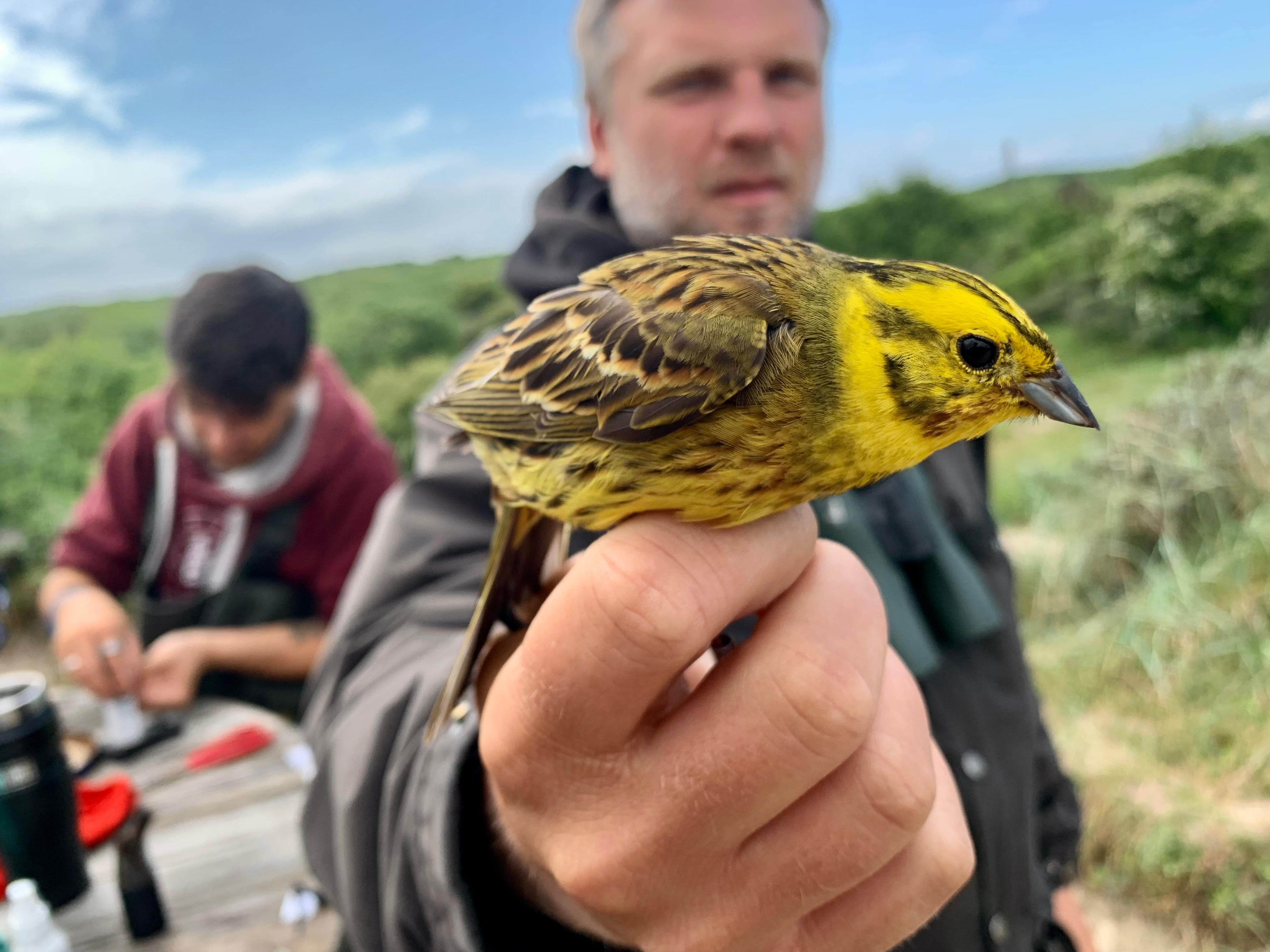
Due to our late start, we were all quite sleepy and just napped the rest of the afternoon away. Simon decided to go 'twitch' some Skovspurv (Tree Sparrows) because he has not yet seen them this month.
And that brings us up to date.. it feels weird, despite the long day due to the late start we really didn't get up to much.
Reed Warbler (Rørsanger) - 5
Eurasian Blackcap (Munk) - 8
Willow Warbler (Løvsanger) - 2
Common Chaffinch (Bogfinke) - 3
Icterine Warbler (Gulbug) - 2
Blackbird (Solsort) - 1
Marsh Warbler (Kærsanger) - 4
Sedge Warbler (Sivsanger) - 1
Common Whitethroat (Tornsanger) - 1
Chiffchaff (Gransanger) - 1
Common Whitethroat (Tornsanger) - 3
Hawfinch (Kernebider) - 2
Total: 28
A link to today's observations from volunteers and local observers.
